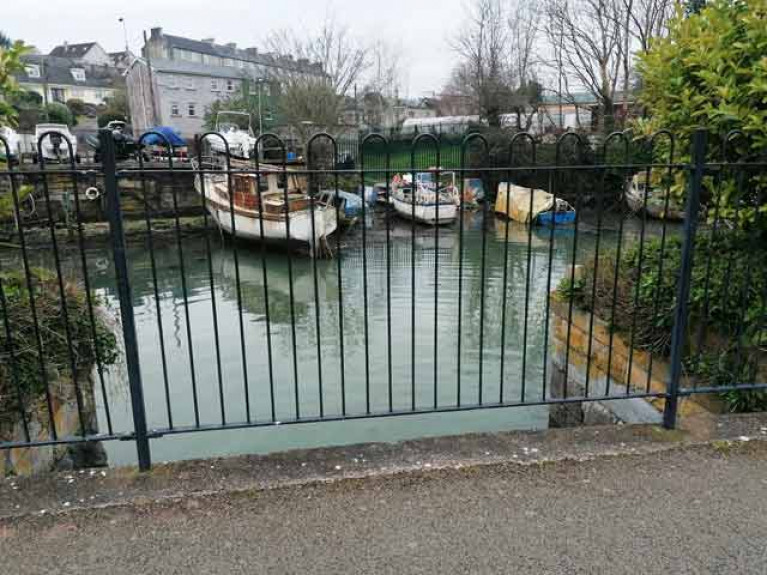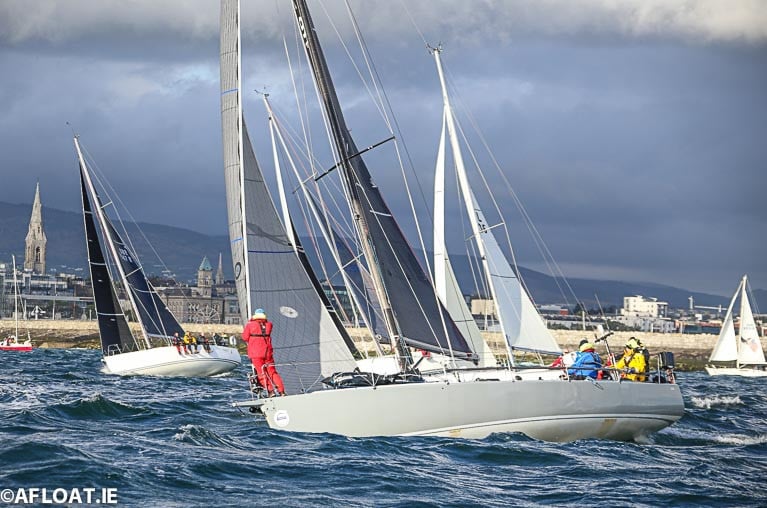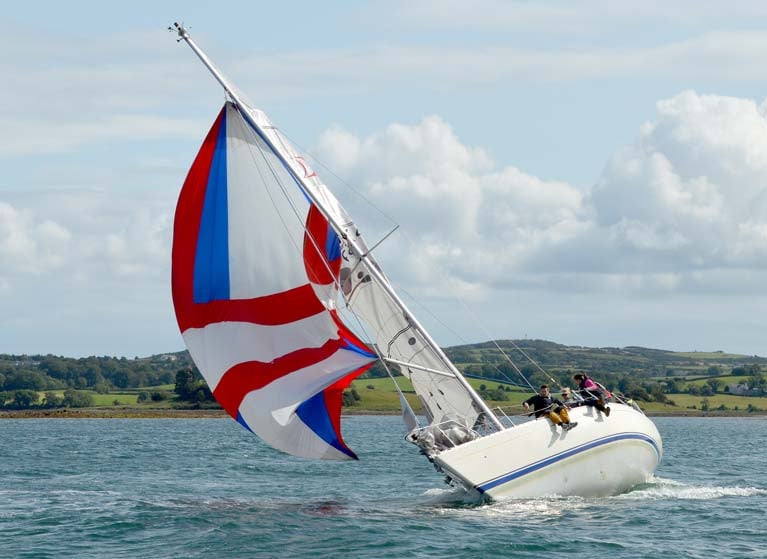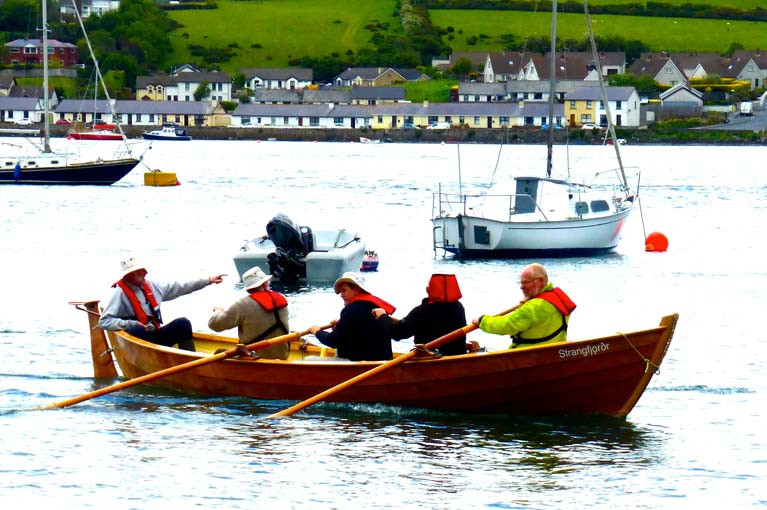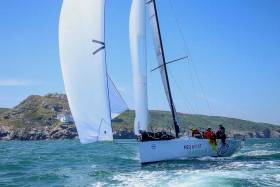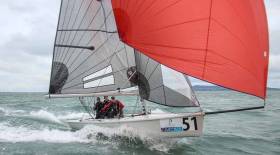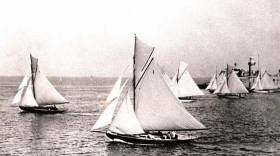Displaying items by tag: sailing
Sailing & Its Widespread Opportunities Should Be Noted
Walking along the riverside in Cork Harbour in the past few days of good weather the harbour waters looked inviting, but as I thought of the pleasure of having the sails up, helm in hand, boat moving through the water, the sound of a bow wave ... the emptiness of the harbour waters told another tale… Along the river walk, I saw boats still lying fenced in.
While Irish Sailing negotiated the difficulties of a return to the water and drafted a plan for discussion with clubs, I pondered over why canoeing had been named as the only waterborne sport included in the initial suggestions for a return of watersports.
So I pursued that with a ‘contact’ of mine, as journalists are wont to have, within the Department of Transport, Tourism and Sport. That single-handed sailing was not mentioned surprised me. My ‘source’ told me that canoeing had been considered because it was “a safe, individual sport, hence social distancing would not be a problem.”
So, why not single-handed sailing – Lasers, Toppers, Optimists – even giving younger sailors a chance to get on the water … The response was that ‘crewed yachts’ had been the focus of concern, where ‘social distancing’ could not be observed…
Now, the core of deciding to go afloat in sailing is based on a combination of self-assessment - of safety, responsibility and risk and that has been put forward by Irish Sailing. I understand the problems of ‘close quarters’ aboard a racing or cruising yacht. As the national sailing authority has suggested, however, what about enabling double-handed sailing, households, family sailing, solo sailing. They should surely be considered, otherwise, a season of little opportunity is ahead.
"overall decisions about local sailing are on hold depending upon what arises from Irish Sailing’s updated plan"
From clubs around the South this week the only positive indicator was that the annual Cobh-to-Blackrock Race, always a well-patronised event, has the best prospect of going ahead because it is not scheduled until September. Decisions are awaited in regard to Glandore Classic Boats in July, but the present uncertainty may affect overseas entrants. Calves Week is still scheduled for August, but overall decisions about local sailing are on hold depending upon what arises from Irish Sailing’s updated plan.
Chief Executive Harry Hermon told me that “the anticipation is that we will be able to go afloat to some degree in Phase 1 of restrictions.”
Hopefully, that will happen but, while not being critical of canoeing as a sport, I’d like to see to more recognition from the Department of Sport of the strong support for sailing and its widespread opportunities.
Listen to the podcast below:
Ireland now has a roadmap to the easing of restrictions from Covid-19 but as Afloat has heard from sailing organisers there is still clarity needed as to how we can return to sailing. Copying what New Zealand is doing as it prepares to get back on the water may point the way for Ireland to implement the 'bubble' concept that permits increased close quarters activity in sport, including sailing.
As well all know now, the only thing that is definite in these troubled times is change – what the World looked like in early March is very different to early May and early July will, no doubt, see even further changes.
Speculation on what the “new normal” will look like occupies much of the media space right now. Countries and regions that are leading the race away from lockdown restrictions are being watched carefully to see their measures and the success or failure of those measures. New Zealand and Australia’s isolation has given them a head start on the rest of the world – it is likely that New Zealand’s 4 alert level plan informed many aspects of Ireland’s 5 phase roadmap.
New Zealand has today, May 4, recorded no new cases. This suggests that a move from the current level 3 to level 2 could happen as early as May 11, allowing boating again, which was not permitted under New Zealand's level 3. There is more on the NZ Bubble in the Evening Standard here. And as Afloat reported previously, the model is something that Professor Sam McConkey, head of the Royal College of Surgeons’ department of international health and tropical medicine, has pointed too. McConkey believes specific sports like single-handed sailing can return to the water soon.
The “bubble” concept is now widely practised – we are largely confined to the household bubble here in Ireland, but as they emerge from strict lockdown protocols, New Zealand and Australia (and some other areas) consider the extension or joining of bubbles to include wider family groups. Indeed, Australia and New Zealand are considering a trans-Tasman bubble to allow travel to resume between the two countries.
It may be possible to use the bubble concept, aligned to testing and tracing, to permit increased close quarters activity in the area of contact sports. A bubble of people, all of whom are Covid-free, could play with another bubble of Covid-free participants.
In sailing, if we can ensure that our crewmates are all Covid-free, then activity could resume. And while this may seem far-fetched right now, the constantly changing environment may permit this in a few month’s time?
There's no doubt the Government publication of its five-level Covid-19 lifting restrictions was well received on Friday because it gave certainty and an idea about the future reopening of Ireland's economy and society.
The roadmap will start from 18 May, from which point the country will re-open in a slow, phased way. Clarity is still needed on some aspects of the 'live plan' but where does it leave sailing and boating and other watersports in Ireland? How the lifting plan is interpreted by the sport's national governing bodies appears to be key to this.
The map sets out five stages for unlocking restrictions, at three-week intervals. As we ease restrictions, the rate of the virus in the community will be constantly monitored by the National Public Health Emergency Team and the government.
The framework sets out how we can keep the level of transmission as low as possible while balancing continuing restrictions proportionately with the positive social and economic benefits which will be brought about by lifting restrictions.
Irish Sailing concluded in March that social distancing is 'not only difficult to achieve onshore from an organisers’ perspective but also difficult to achieve at a personal level on the water'. The National Governing Body submitted a plan on a return to sailing requested by the Department of Sport in mid-April. This submission document was not published but an 'overview' of IS recommendations are here.
Peter Ryan of ISORA told Afloat this morning that the lifting looks like it has some 'conflicting conditions' which will be hard to work with. He cites, for example, the sport of Rugby with social distancing? The offshore chief, who redrafted the 2020 Irish Sea calendar last week (that has its first race now scheduled for June 13), says ISORA will have to see how Irish Sailing and the Royal Yachting Association interprets the lifting conditions.
The Irish Marine Federation has lobbied for a resumption to recreational boating at the earliest possibility and Friday's roadmap has been given a thumbs up by many in the industry who were otherwise looking at a season with zero activity.
We are in lockdown for another fortnight to contemplate all of this but here's a first look at what it might mean from a sailing and boating perspective.
Government's five-phase roadmap & what it might mean for sailing & boating
- Phase 1 (18th May) Outdoor spaces and tourism sites (for example car parks, beaches, mountain walks) will be opened where people can move around freely and where social distancing can be maintained. Public sports amenities (for example pitches, tennis courts, golf courses) can be opened where social distancing can be maintained. This has largely been taken by many of the marinas around the country as a date for reopening in a phased way. Will it allow people to go out on their boats, in small groups? Will the five-kilometre travel restriction that also applies mean those that are outside that limit be unable to attend their boat?
-
Phase 2 (8 June) People can take part in outdoor sporting and fitness activities, involving team sports training in small groups (but not matches) where social distancing can be maintained and where there is no contact. This puts boats back on the water for sailing and training with limited crews to comply with social distancing.
-
Phase 3 (29 June) Sporting activities and events can resume “behind closed doors”, where arrangements are in place to enable participants to maintain social distancing. Does this allow racing to begin but with a smaller crew number to comply with social distancing?
- Phase 4 (20 July) Competitions for sports teams (for example, soccer and GAA) can resume, but only where limitations are placed on the numbers of spectators and where social distancing can be maintained. Restaurants to open.
- Phase 5 (10 August)
Close physical contact sports, such as rugby and boxing, can resume. Gyms, dance studios and sports clubs can re-open, only where regular and effective cleaning can be carried out and social distancing can be maintained. Spectators can begin to attend live sporting events only in accordance with both indoor and outdoor number restrictions and where social distancing can be complied with. Festivals, events and other social and cultural mass gatherings can take place only in accordance with both indoor and outdoor number restrictions and where social distancing can be complied with.
 Staying the course – the Government Roadmap (downloadable below in a higher resolution format)
Staying the course – the Government Roadmap (downloadable below in a higher resolution format)
2020 Sailing Fixtures & Events
While we await clarification on the above, Regatta organisers will no doubt be poring over the fine print. With so many fixtures already cancelled, what will the timing of these phases mean for the main 2020 sailing events? What is the date that multi-crewed boats can go back sailing? Is it at Phase Five or could it even begin at Phase Three where Government says "Sporting activities and events can resume behind closed doors”, where arrangements are in place to enable participants to maintain social distancing?
Dublin Bay Sailing Club
DBSC Commodore Jonathan Nicholson wrote to members last month advising them to be 'ready to race' when restrictions are lifted. Does this mean the DBSC summer racing could start by Phase Three at the end of June with small crew numbers participating or will it be later? There are obvious problems for two-handers and day boats to sail, however. The club, the largest racing club in the country, surveyed its members on attitudes towards racing this season, a summary of which has been posted on the club website, shows that there is a clear appetite to go racing, regardless of the start date. In response to questions from Afloat in light of the Government roadmap, Nicholson said on Sunday, "DBSC awaits guidance from Irish Sailing as to when [DBSC] racing can commence."
and it will be interesting to learn of the results from over 1,200 members from DBSC's combined 250-boat fleet.
ISORA
Irish Sea offshore racing could also commence at the end of June keeping alive the revised 2020 fixture just published by the offshore association. Then, with small crew numbers, would it allow the Dun Laoghaire to Cobh race at the end of July? ISORA Chair Peter Ryan intends to ask Irish Sailing and the RYA for their interpretation of the lifting conditions.
Dun Laoghaire 'Solidarity' Regatta
The proposed three day Dun Laoghaire Combined event at the start of August could go ahead on the water, but club bars and restaurants will not be not open at that stage. It would be nice to think that given the nature of the set up in Dun Laoghaire (with four separate waterfront clubs) that some outdoor shoreside social could exist with social distancing in place?
Calves Week
West Cork's Calves Week on from Tuesday 4th August to Friday 7th August is a week the wrong side of Bars opening so although this regatta can happen on water alternative arrangements would need to be made for festivities ashore?
Round Ireland Race
Round Ireland's postponed date of August 22nd looks OK for the 700-mile biennial race that despite the COVID-19 setbacks looks like it might gather a record fleet. But will it now occur with smaller crew numbers, perhaps working two watches with only one watch on deck at a time?
Wave/ICRA Nationals
As Afloat reported yesterday, Howth Yacht Club's Wave Regatta that incorporates the ICRA Nationals from September 11-13 is gaining in appeal. The inaugural regatta in 2018 attracted a large crowd and while festivals can return, social distancing will continue. Chairman Brian Turvey has told Afloat "it appears to me that all going well, August 10th might be the date where we can all go back sailing and racing on multi-crewed boats. That would give us a month to refine our already evolving COVID-19 preparations. We’re already looking at doing temperature control checks, online crew symptom checking and branded face masks for all competitors".
Crew numbers on yachts & keelboats?
With contact sports like GAA and Soccer being allowed to train and play matches, it means there is scope for sailing too. Should crew numbers on boats be kept to a minimum? How can this be achieved? Perhaps a scale like this might be useful for cruiser-racers:
- 45 footers - allow 7 max
- 40 footer - allow 6 max
- 35 footer - allow 5 max
- 30 footer - allow 4 max
- 25 footer - allow 3 max
Day keelboats and two-man dinghies will have bigger problems, however, as it is hard to separate/reduce crew in the likes of sports boats and one-design keelboats.
Comments
Afloat is interested in all comments on the 'Return to Sailing & Boating' either below in our comments section, on Facebook or directly to our web editor here. Stay Home. Stay Safe.
Comment from John Giles, Yacht Artemis, Dun Laoghaire: Certainly, the overall lobbying to remove the lockdown to commence racing at DL is well managed. However, the plight of the non-racing solo or small boat sailor seems ignored. These people's boats are swinging at their moorings (or in the marina), single-handed sailed they are low risk in social terms and there is no good reason why owners could not be allowed access.
Comment from Ruth Walsh, crew Cruisers One, DBSC. I did not participate in the [DBSC] survey. As a crew, I would love to go sailing and take a break from the coronavirus regime. Boat owners have a duty of care to their crew and all families and colleagues of essential workers who cannot work from home associated with their boat. Also, safety ribs and RNLI crew have the same duty of care. The above was not mentioned in your [DBSC] survey. 2020 will be a year of onshore training at best. Swimming the sea has been my preferred option.

2020 Irish Sailing Fixtures (The Beyond COVID-19 Version)
The Government is preparing for a 'controlled and gradual return to sport' and the 2020 sailing fixtures are being tentatively redrafted by yacht clubs across Ireland as the country enters a new phase in dealing with the Coronavirus.
The Taoiseach told the Dáil this week that the Government would like to set out a roadmap before 5 May on how the COVID-19 restrictions might be eased. In turn, as Afloat reported, Sport Ireland has asked national governing bodies for information on the challenges they face.
In further good news in the fight against the disease, in an interview on RTÉ's The Late Late Show last Friday night (April 17), Chief Medical Officer Dr Tony Holohan said that the COVID-19 curve has now been flattened and that there is no 'peak' coming. Report here.
Scroll back through Afloat's original 2020 sailing fixtures preview published last November here and you will find most of the early summer events are wiped out. Even Afloat's article, What will happen to this Summer's Sailing Events? dated March 18th seems very old now, so much has happened in the meantime. One month later, we certainly have some answers to that question and only last Friday (April 17th) the Fireball World Championships slated for Howth in August became the latest casualty to be scrubbed, organisers citing 'the impossibility of getting any fix on the timing of a return to normality'.
Like all sports, sailing is trying to work out what happens next in 2020 and if there can be a return to activities and what shape it can take.
Flag officers and regatta organisers are beginning to lay out new plans, formulate COVID-19 protocols and put a new calendar in place. It's far from plain sailing but the fact that clubs, industry and sailors are all talking about a return is evidence of progress as we enter a new phase in dealing with the disease. Maybe there is a chance of a competitive and rewarding season, after all?
National Yacht Club Commodore Martin McCarthy in Dun Laoghaire told cocooned members this week that the 'end is almost in sight'. McCarthy says the NYC continues to 'scenario plan' and 'hopes to be back in the water in June or July'. 'After the storm is at its worst, the new weather starts coming into sight', he said in this week's NYC email update.
Coming up with a tailored approach to what can be done safely within the government guidelines and communicating that strategy to get the sport through 12 to 18 months while we wait for a vaccine seems the right thing to do.
Dublin Bay Sailing - "Be prepared and ready to race"
Chris Moore, the Honorary Secretary of Dublin Bay Sailing Club (DBSC), the country's biggest racing club, says the emphasis is definitely on going sailing this summer. "We are looking at various scenarios, and it's still tough to call". There could be no sailing at all, or it could be a hectic second half of the season!"
DBSC Commodore Jonathan Nicholson told members 'before racing can commence, clearly, the restrictions imposed by our government must be lifted, approval is given by our national governing body Irish Sailing and the lift-in of the boats from the various waterfront clubs completed. When these preconditions have been met, it is our intention to commence the revised programme immediately. Please be prepared and ready to race".
There have already been great sacrifices in the sailing calendar as big events move to the end of the summer to give them the best chance of happening. Even with that, some are saying, 'it is still very much 50:50' and shoreside gatherings are very much in doubt.
WAVE Regatta & ICRA Nationals
As regular Afloat readers know, ICRA Commodore Richard Colwell has been forced to move the cruiser-racers from Cork to Howth for its Championships after Cork Week was cancelled. 'It's prudent in the current environment, to delay the important National Championships until as late as possible to try and ensure it goes ahead this year, so we have taken up the offer from Howth Yacht Club to combine the event with the WAVE Regatta in September.'
The Irish IRC season has always been very front-loaded, with nearly all the significant events completed by mid-July. This year, if we are lucky, the season will only likely be starting then.
Even if the season extends into October, many classes will be trying to run championships. Hence, there is a need to rationalise what can be done and avoid congestion in the remaining squeezed timeframe.
Round Ireland Race
The news that the Round Ireland Race has been postponed for two months until 22nd August is excellent news for owners concerned this classic offshore race would be running at all.
With a good run-in needed for the Round Ireland due to qualification requirements, it was doubtful that the race would ever have gone ahead in June anyway. The fact that the new date was greeted with such enthusiasm is, as Afloat's WM Nixon points out, a measure of the 700-mile race's importance to Irish sailing.
Some other significant events were not so fortunate, however, and they were not in a position to postpone to a later date. The Scottish Series is gone in May and following events like Bangor Week in June and Cork Week in July have both been lost. Cowes Week in the UK has confirmed it is still planning to go ahead in August as has the Welsh IRC Championships.
Call it wishful thinking but based on what is currently being talked about, here are some non-exhaustive 'thoughts' to get value from boats this season and some competitive racing to boot.
- Dublin Bay SC racing - twice weekly in July, and after that, right through to late September is a scenario being considered.
- Dun Laoghaire Club Regattas - A new date for a three day combined event for all waterfront club regattas is currently being hatched for July or August. This could include the National Yacht Club's Sesquicentennial event. UPDATE: July 31st has been announced for the 'Dun Laoghaire Club's Solidarity Regatta'.
- ISORA racing - in June, July, August and September would still produce an excellent series even though losing early coastal and offshore races mean ISORA will rejig its calendar.
- Glandore Classic Regatta - Glandore, West Cork (July 18th)
- Dun Laoghaire Club's Solidarity Regatta (31st July-3 August)
- Calves Week, Schull West Cork (4th to 7th August)
- SSE Renewables Round Ireland Race (22nd August)
- Dragon Gold Cup - Kinsale, (September 3rd)
- WAVE Regatta, incorporating ICRA Nationals (13th September)
- Autumn Leagues - Howth and Royal Cork Yacht Club (October)
- Dublin Bay SC Turkey Shoot - November 1st
That's an outline of the season, without even mentioning class championships or the one design calendars at this early stage.
There seems to be plenty of options depending on whether crews want to stay local or are keen to venture further afield.
If ISORA rejigs its programme, as expected, and reschedules the Kingstown to Queenstown race for July 31st, it would, as Afloat's WM Nixon points out here be a way of getting boats to Cork and then on to Calves Week in West Cork.
For those not wanting to go to Cork, there looks like there will be club regatta options on Dublin Bay and there is the Welsh IRC Championships in Pwllheli from the 14th to 16th August. The following week there is Abersoch Keelboat Week but this date clashes with the Round Ireland Race.
On the West coast of Ireland, WIORA will have their popular week at Tralee Bay, presently scheduled for late June, but this may also need to be moved to a later date.
As WM Nixon says here, if the ISORA Dublin Bay to Cork Harbour Race is implemented, crews could be campaigning almost continually from July 31st until the conclusion of the ICRA Nationals in the Wave Regatta at Howth from September 11th to 13th.
It is certainly shaping up to be a season like no other. With luck, if planning and new protocols are successful, sailing will be back and there can still be a rewarding season ahead.
Return to Sailing? Government Seeks Information on Covid 19 Challenges Faced By Sport
Government is seeking input from sports bodies – including sailing – as to how a 'gradual and controlled' return to activities can be achieved.
Yesterday, the Taoiseach told the Dáil that the Government would like to set out a roadmap before 5 May on how the COVID-19 restrictions might be eased.
Leo Varadkar said that this would be done on the understanding that the plan could change and steps could be reversed.
At the same time, the 2020 sailing fixtures is being redrafted by yacht clubs around the coast in anticipation of a resumption sometime this summer.
Already single-handed sailing could return 'relatively soon', according to experts, but does anyone know what sailing in Coronavirus Ireland will be like in 2020?
There is going to be a 'new normal' in society, and the Government expects the practice of social distancing will be with us until we find a COVID-19 vaccine.
It could be over a year or more before a vaccine is widely available and before people begin to feel safe again.
"what will sailing in Coronavirus Ireland be like in 2020?"
But we are moving into the next phase of co-existing with the virus and a key task for the government is managing the return of sport.
On Wednesday, Sport Ireland wrote to national governing bodies, including Irish Sailing, asking for their views on how a 'gradual and controlled return of sport' can be completed.
Minister of State for Sport Brendan Griffin told stakeholders he wants to know the specific challenges that sports face, the possible scenarios sailing will confront and its key concerns.
The government also wants to see draft protocol proposals on how sailing is planning to get back on the water.
The request says it would also like relevant guidance and intelligence from international bodies, in sailing's case this is World Sailing.
Harry Hermon of Irish Sailing said here that for 'double handers and/or keelboats requiring two or more crew, it is not possible [to practise social distancing]. Even for organised activities involving single-handers requiring safety cover (with two people in the safety boat), it is not achievable'. So if the practice of social distancing will continue after restrictions are eased, how is it possible to go yacht racing or double-handed dinghy sailing at all?
It's a question both government and sailors themselves would like an answer to because 80% of all sailing in Ireland is on crewed boats.
Meanwhile, Professor Sam McConkey, head of the Royal College of Surgeons’ department of international health and tropical medicine, believes specific sports like single-handed sailing and horse racing can return "with a two-metre social distancing rule in place very soon". McConkey also says, ideally, Ireland should follow the 'bubble' strategy pursued by New Zealand. His full interview with Gavin Cummiskey is in the Irish Times here.
Update 18/4/20: The Irish Marine Federation (IMF) has called on the Government to consider easing some restrictions. In a letter to Brendan Griffin TD, Minister of State for Tourism and Sport, as seen by Afloat.ie, IMF chairman Paal Janson says boating is one of the more 'responsible and acceptable forms of enjoying the outdoors'. Janson outlines a series of protocols to enable boating here
The request from Sport Ireland to the NGBs is reproduced below:
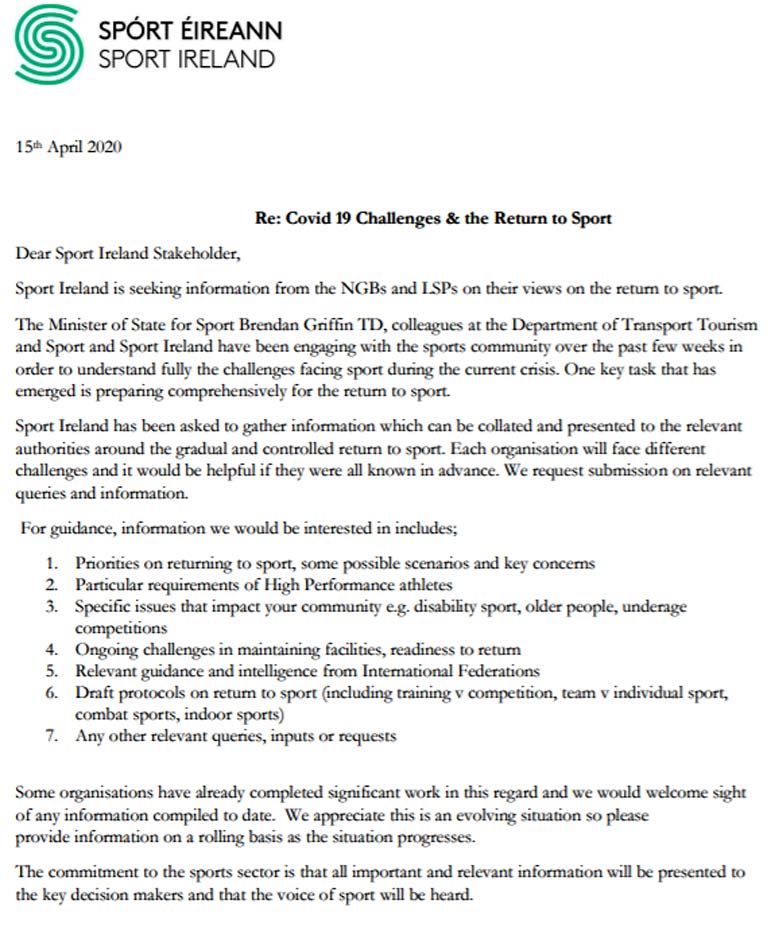
Sailing with a Spinnaker & Living on the Edge!
The yacht pictured above this week is definitely not aground, though it is at a critical angle.
It is a Sigma 33 racing at Quoile Yacht Club on Strangford Lough.
“We do have these interesting moments with spinnakers on these boats. This boat is definitely not aground,” says Peter Mullan in response to my recent Podcast about spinnakers and my own Sigma 33 experience. “You have a somewhat reluctant view of the glory of kites” and “that’s a lot of aversion to spinnakers” were amongst responses.
There are certainly mixed views about spinnakers, though “there is no doubting the “enjoyment and thrill they give, living on the edge, it’s great!” said another Email.
Peter Mullan’s photo recalled for me other moments with a spinnaker flying.
"there is no doubting the “enjoyment and thrill they give, living on the edge"
Off-watch in my bunk on the West Coast aboard John Killeen’s 44ft. ‘Mayhem’ out of Galway Bay Sailing Club in the Round Ireland Race. As she rose to a wave with the kite up there would be a great cheer from the Galwegians I was sailing with as Mayhem raced forwards, downwards it seemed to me braced in the bunk, then poised or shuddered, which was my impression of the moment as she picked up, the spinnaker gave her more power and she was away again, the Galwegians repeating the process time and again!
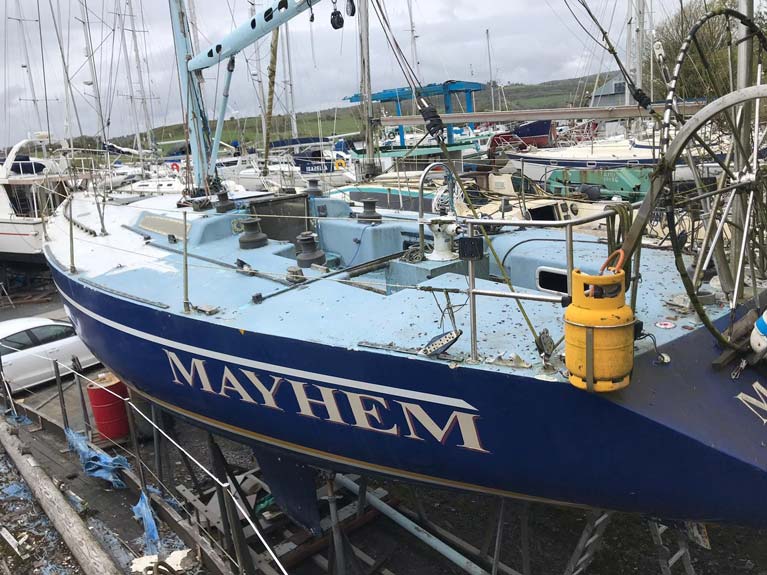 Mayhem, a Doug Peterson 40 of 1981 vintage
Mayhem, a Doug Peterson 40 of 1981 vintage
I’ve been trying to trace the origins of spinnakers, about which there seem to be several views. The origins of the name are lost in time, it seems to me.
There is one view that the spinnaker, described as “the colourful sail that can lead to equal amounts of delight and dread onboard yachts,” was first carried by a yacht in Cowes, off the Isle of Wight called Sphinx, or in some places named as ‘Spinx’ and that this new style of sail was then set in the Solent. That is contradicted by claims that the first boat to use a spinnaker was Niobe, owned by William Gordon and that one of his crew when they saw it said the sail would “make the boat spin” and so it became known as a spinnaker and William was called “Spinnaker Gordon”.
But then, Thames sailing barges used the term spinnaker for their jib staysails.
So, there’s no clear agreement about the origins.
There were spinnakers from Code Zero upwards on yachts that I have sailed on …. which took plenty of grabbing to get them down and even falling on top of at times in high winds to smother as they whirled like dancing dervishes about the bow`. And I remember the regular warning shout from the deck of NCB Ireland as we raced across the Atlantic in the Whitbread Round the World Race when the spinnaker was downed and, in your bunk you’d hear a shout as it was dumped down the hatch, spray often flying everywhere, followed by bodies grabbing it to rebag and ready it for the next launch. I remember it well as I learned how to bag the kite quickly and pray that when it went up again it was without a twist!
And I still remember those whoops of the Mayhem crew which convinced me that sailing on the West Coast was an “entirely different process.”
Keeping Ireland’s Sailing & Boating Communities in Good Health is Always Work in Progress
This weekend two years ago, Storm Emma was sweeping Ireland, with onshore hurricane-force winds attacking much of the East Coast and wrecking a shed on Howth’s East Pier where, for decades, boats of the 1898-founded Howth Seventeen Foot class had been kept for winter storage.
Seven boats had varying degrees of such extensive damage that it was initially feared it could be a mortal blow for a historic class which was seen as a symbol of its characterful home port, for seven boats meant that pessimists feared that a third of the fleet had been wiped out.
But the class’s collective spirit - its instinctive sense of community - saw a group of 20 owners and crews and friends being assembled on the strength of their range of talents and access to lifting machinery. As soon as the storm had subsided, they were at work saving the boats from further damage by removing them from a place now in danger of total collapse. When darkness fell at the end of that “Day of Saving”, the seven boats were in a place of safety.
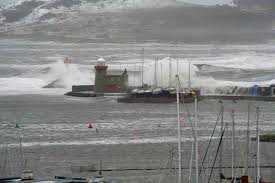 On this day two years ago, Storm Emma had arrived. Somewhere under that wave breaking over Howth’s East Pier is the shed housing seven of the classic Howth 17s
On this day two years ago, Storm Emma had arrived. Somewhere under that wave breaking over Howth’s East Pier is the shed housing seven of the classic Howth 17s
 The aftermath. Yet in just one day, all seven boats had been removed to safety, and only one was a total loss
The aftermath. Yet in just one day, all seven boats had been removed to safety, and only one was a total loss
Just one was a total loss, while the rest needed various levels of work – admittedly including major projects - to bring them back to full seaworthiness. But now the class is restored to fuller health and greater numbers than it has ever enjoyed before, with the “total loss” boat re-built thanks to some brilliant management by Ian Malcolm, and new enthusiasts are keen to join a class which so obviously provides such a vibrant sense of community.
However, we do not need such a specific yet ultimately manageable setback to demonstrate an attractive sense of community within most sections of the sailing and boating population. It’s to be found in all successful classes, this community spirit which - to put it at its most basic - can be a very successful marketing tool for those concerned with maintaining and maybe increasing numbers in sailing. But an extreme example such as the effects of Storm Emma emphasised just how important these communities, these “small platoons”, are within society as a whole.
 Back to normal. The Howth 17s are now back to full strength, and much of their racing is done from a convenient pier–based start line. This is third generation Howth 17 owner-skipper Peter Courtney racing Oonagh in Howth Sound. Photo: David O’Shea
Back to normal. The Howth 17s are now back to full strength, and much of their racing is done from a convenient pier–based start line. This is third generation Howth 17 owner-skipper Peter Courtney racing Oonagh in Howth Sound. Photo: David O’Shea
Yet it is a mistake to think that a sense of community is something to be aimed for along some tunnel-vision route. On the contrary, it is surely more realistic to accept that a sense of community is a valuable by-product, the attractive evidence of shared enthusiasms and a welcome result of working together and taking part in group activities which are enlivened by a level of healthy competition when the boats are afloat.
It’s something which can be found in all areas of life, and in sailing and boating it manifests itself in many ways. One of the most clear-cut in Ireland is the class associations, which are as various in their character as their boats are in their types. All share a sense of community that is as natural as breathing which - while vitally important - exists as something almost incidental.
The Gold Standard in class associations is probably set by the GP 14s, who are seeing an increase in activity with the 2020 Worlds being staged in Skerries from July 25th to 31st. The Lasers may be bigger numerically, but they are solo sailed to create their own simpler dynamic, whereas the two-handed GP 14s have the need of added sailing abilities as they set a spinnaker, together with the demands of extra social skills and crew recruitment logistics.
 The Gold Standard in Irish class associations – hard driving for the GP 14s
The Gold Standard in Irish class associations – hard driving for the GP 14s
There are many other One Design classes which share the powerful community ethic of sailing which lends itself to promoting this Sport for Life. Anyone who has ever seen the group activity which is the thriving Flying Fifteens at the National YC in Dun Laoghaire operating their purpose-designed launching and retrieval system will be impressed and aware of the vigour of this particular setup.
In the end, it is the prospect of regular quality racing which is the real engine in keeping any class motoring along. Yet even here, realistic local expectations are much more relevant than high-flown aspirations towards course-setting perfection in yacht racing.
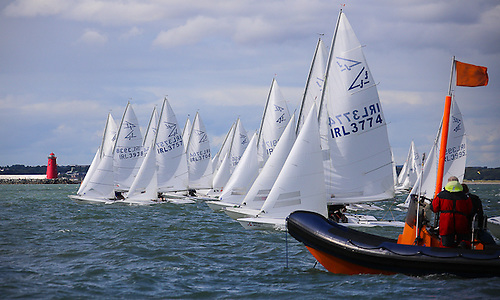 Flying Fifteens in Dublin Bay. Their co-ordinated launching and retrieval system at the National Yacht Club is a wonder to behold. Photo Afloat.ie/David O’Brien
Flying Fifteens in Dublin Bay. Their co-ordinated launching and retrieval system at the National Yacht Club is a wonder to behold. Photo Afloat.ie/David O’Brien
The mantra in business schools is Voltaire’s statement that Perfection is the Enemy of the Good. You’ll achieve much more overall if you’re happy enough with 85% achievement than if you’ve busted your gut and driven everyone crazy in getting to 97% of the arbitrary ideal, and back in Sailing on Saturday at the end of last August we were warbling on along these lines.
Some cheeky but unpublishable personal emails showed we were hitting the target for some folk, but we’d felt a bit like a voice crying in the wilderness until North Sails recently published the musings of their President Ken Read, which put the whole matter with much more authority
 The President of North Sails in Galway during the Volvo Ocean Race. Ken Read is one of sailing’s great sports. Photo: VOR
The President of North Sails in Galway during the Volvo Ocean Race. Ken Read is one of sailing’s great sports. Photo: VOR
Ken Read is a good sport who can put the fun back into sailing when the opportunity arises, so let’s hear it for modern sailmakers for the great work they do in making Irish classic boats look much more attractive. In the old days, boats such as those two Dublin Bay specials, the Mermaids and the Water Wags, tended to have an unattractively starved look to their sails, which were no bigger and generous than was necessary, and were often unmatched and of different generations.
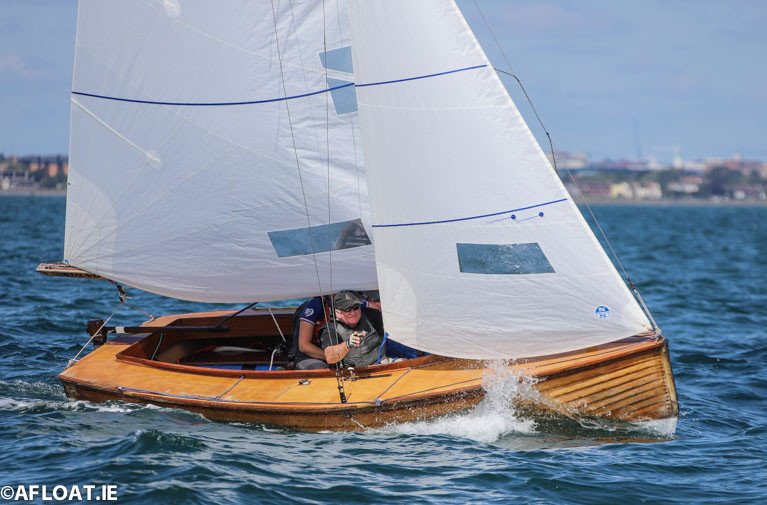 Suits you, sir…..The new style North Sails work wonders for the look of a venerable Mermaid. Photo: Afloat.ie/David O’Brien
Suits you, sir…..The new style North Sails work wonders for the look of a venerable Mermaid. Photo: Afloat.ie/David O’Brien
But today’s sails have freshened things up no end. A contemporary and stylishly complete suit with a loose-footed main with its own ample curve in the foot has given these old girls a new lease of life. And in the case of the Water Wags, the boats have the bonus of being the height of fashion in Dun Laoghaire, so much so that specialist builder Rui Ferreira of Ballydehob in West Cork is bringing new Water Wag No 51 to immaculate completion for noted Dragon sailor Denis Bergin.
For those who complain that these boats are of a concept which is ancient - the Water Wags date back to a 1900 design in a class which originated in 1887, while the Mermaids are from 1932 - we’d point out that, astonishingly, the Laser is now past the Golden Jubilee mark.
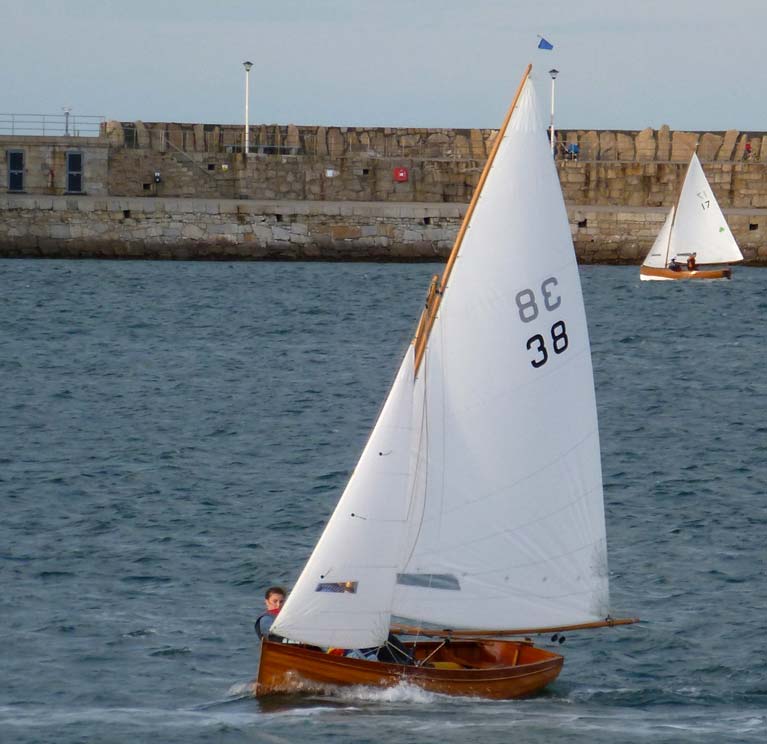 Full and generous. Modern sails go well on Guy Kilroy’s Dublin Bay Water Wag Swift. Photo: W M Nixon
Full and generous. Modern sails go well on Guy Kilroy’s Dublin Bay Water Wag Swift. Photo: W M Nixon
And one of the most useful International One Designs in Ireland, the J/24, is not only 55 years old, but she was right up to speed in being created by designer Rod Johnstone and his co-builder brother Bob in their parents’ garage in Stonington, Connecticut in 1975. The boat become 24ft LOA because that was the biggest they could build her without actually knocking out an end wall, and the use of a Stonington garage on America’s east long pre-dated the American garage’s sacred role in the creation of Silicon Valley out west.
But here again the vitality of the J/24s, as with the other classes mentioned, is dependent on personally-owned (or in the case of the J/24s, syndicate-owned) craft being campaigned in a satisfying season-long programme, which may not appeal in the modern age with its fondness for life in a tasting menu. So the clubs are providing club-owned boats for occasional sailors who fear total commitment, and while there’s an element of “What’s everybody’s business is nobody’s business” about these communally-owned craft”, every so often they attract a rush of enthusiasm.
Another approach in attracting people towards boats and the sea is that it should all be part of a complete process including the building of the boat, which was seen with the 2012 completion of the absolutely charming 25ft gaff cutter Sally O’Keeffe designed by Myles Stapleton for the Seol Sionna group in West Clare, with Sally being constructed in a community effort guided by master boatbuilder Steve Morris in a large barn obligingly provided by a farmer at Querrin down towards Loop Head.
 The community-built gaff cutter Sally O’Keeffe has introduced hundreds of people to the sea and sailing at Kilrush on the Shannon Estuary
The community-built gaff cutter Sally O’Keeffe has introduced hundreds of people to the sea and sailing at Kilrush on the Shannon Estuary
Since she started sailing, Sally O’Keeffe has turned heads the length and breadth of the mighty Shannon Estuary, and has impressed with appearances at Cruinnui na mBad at Kinvara on Galway Bay, the Baltimore Wooden Boat festival in West Cork, and the Glandore Classics further eastward on the south coast of Cork, having gallantly sailed to all these places along the challenging Atlantic seaboard.
Back at her home port of Kilrush, she has been used for sailing and seafaring courses which have involved getting hundred of people afloat, the most senior being 90-year-old Miss Josephine Glynn of the long-established Kilrush family.
As the years have passed since Sally was first commissioned, it has become increasingly clear that another instructional boat-building project at Kilrush would be useful, and the opportunity to provide this has arrived through the BIM (Bord Iascaigh Mhara) FLAG scheme, which is operational from 2016 to 2023.
Most will know of it, but FLAG is Fisheries Local Area Group Development Scheme. The idea is to make funds available to smaller coastal ports and communities which have suffered economically and socially from the decline in small craft fishing activity, thanks to factors as various as the salmon netting ban, limitations on size of catch, and ever more efficient larger boats taking the small boats’ catch in a more economical style.
In Kilrush, they’ve got the idea that Seol Sionna should broaden its remit to include coastal rowing and the building of one of the Iain Oughtred-designed St Ayle’s Skiffs. They have proven a success around Strangford Lough as they’re just 22ft long, light and handy to built by the edge-glued marine ply method, making them a much more manageable proposition than the traditional and majestic 32ft-plus LOA traditional clinker skiffs which are the backbone of much Irish coastal rowing.
 Members of Seol Sionna aboard Sally O’Keeffe in Kilrush (Steve Morris is second from left in bow). Their next project is building a St Ayle’s Skiff. Photo: W M Nixon
Members of Seol Sionna aboard Sally O’Keeffe in Kilrush (Steve Morris is second from left in bow). Their next project is building a St Ayle’s Skiff. Photo: W M Nixon
With Luke Aston and Gerard Concannon putting Kilrush’s case for a complete St Ayle’s Skiff project which will comprise a complete building kit and a purpose-designed road trailer from Jordan Boats, they find they’ve hit the button spot on with a 100% grant from FLAG.
The first boat will be built as a proper Training Project under the direction of Steve Morris, James Madigan and Dan Mill, and while it’s for members of Seol Sionna, new members are very welcome and membership fees are a reasonable €60 for family, €40 for single, and concession for €20.
For those interested, try phoning Steve Morris at 087 799 0091 for details of what will assuredly be a rewarding and satisfying process ashore and afloat, as the St Ayle’s Skiff has so perfectly hit the target that they’re now being built worldwide.
 Their popularity is spreading worldwide – a St Ayle’s skiff under construction in Australia
Their popularity is spreading worldwide – a St Ayle’s skiff under construction in Australia
As for BIM’s FLAG scheme, its applications can be very wide indeed, and it was of course used late last year to fund the six new Fireflies with which Irish Sailing is putting on Team Racing Instructional Roadshow under the direction of Rory Martin. We hasten to make the point that this is not done with the intention of holding a team racing tournament at each venue visited, rather it’s to give instructional insight into the tricks of the team racing trade.
The first instructional demo by the new Firefly squad took place in Dun Laoghaire last November, and in a week’s time they’re in Howth. This is a bit ironic, as it’s the high-powered fishing craft that frequent Howth which have done so much to change the face of the industry.
Not that there are many Howth owners involved these days. The sons and daughters of the old Howth fishing families are as likely as not to be found trawling documentation as corporate lawyers in the IFSC rather than trawling fishing nets through Ireland’s seas. But what goes round comes round, and it could well be that sons and daughters of those same corporate lawyers will be attracted to sailing thanks to the availability of it through Irish Sailing’s Team Racing Fireflies.
 Close racing among St Ayles skiffs – their basic design origins are Viking by way of the East Coast of Scotland
Close racing among St Ayles skiffs – their basic design origins are Viking by way of the East Coast of Scotland
2020 Irish Sailing Fixtures Preview: The Year of the Irish Sailing Club
Nobody seems yet to have nominated the already very special 2020 as The Year of the Sailing Club, or more accurately as The Year of the Irish Sailing Club. So here in Afloat.ie we’re just going to do that very thing right now. Let’s hear it for our Irish sailing clubs, our sometimes crazy clubs in all their wonderful diversity, their huge levels of voluntary enthusiasm, and the remarkable achievements afloat of their members - both at home and abroad - particularly when set against the small population of the island.
Admittedly, in the big picture, 2020 is still primarily the Year of Cork300. But it is the inspiring example set 300 years ago by the pioneering sailors of Cork in establishing what became in time the Royal Cork Yacht Club which means that, in 2020, so many Irish sailing clubs will have their own special anniversaries to celebrate.
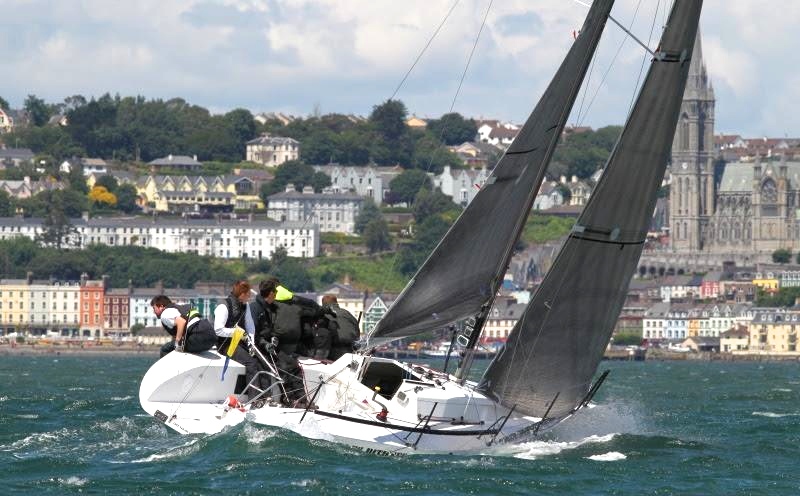 In-harbour racing during Cork Week. The inspiration from the founding of the Water Club of the Harbour of Cork in 1720 has filtered through into a tradition of long-lived Irish sailing clubs
In-harbour racing during Cork Week. The inspiration from the founding of the Water Club of the Harbour of Cork in 1720 has filtered through into a tradition of long-lived Irish sailing clubs
Sports clubs can be very odd organisations. While comparisons can easily find close similarities among them, each is unique in its own way, and those involved can only hope their club – which relies so much on voluntary effort – will continue to develop its own almost self-sustaining vitality to provide the continuity which is a golden thread running through the community in which it aspires to thrive.
Most of us will accept that our beloved clubs are not perfect. But nor is parliamentary democracy as a way of national government. Yet it seems to be more acceptable than any of the alternatives, provided that everyone realizes it is something which won’t run on its own – democracy is hard work, requiring vigilance and the constant monitoring of one’s own mindset. That is easy enough to say, but extremely difficult to maintain on a day-to-day basis.
Equally, a successful sailing club is not just for regatta days. On the contrary, its spirit has to be sustained on a year-round basis. And the fascinating thing about the history of recreational sailing is that Ireland has – almost by accident – been a world leader in the development of the concept of the successful yacht and sailing club.
Three weeks ago, we had a preview here of the 2020 sailing season, which was deliberately structured around the fact that the over-arching reality in 2020 is the Tricentenary of the Royal Cork Yacht Club, an anniversary which may trip easily enough off the tongue, but it’s extremely difficult to grasp in all its true meaning.
After all, the Club in Cork had already been actively in existence for 56 years – inspiring masterpieces of maritime art and gems of historical writing – when the United States of America was founded in 1776. For many folk, that’s when history really began. Yet by the time the fledgeling nation across the Atlantic was beginning began to flex its muscles, the Club in Cork had seen its Golden Jubilee, and was functioning as a sporting and social organisation for the benefit of its fellow-minded members in a way which we can easily recognize today.
 Summertime at Lough Ree Yacht Club, which has been quietly going about its business of providing boating and sailing for 250 years. Photo: W M Nixon
Summertime at Lough Ree Yacht Club, which has been quietly going about its business of providing boating and sailing for 250 years. Photo: W M Nixon
The celebrations of the Royal Cork will be at their peak throughout the month of July in a mind-boggling programme which continues to be refined, and then in August they’ll be staging at least three major dinghy championships. But while this week’s Sailing on Saturdays may be concentrating on other aspects of 2020’s fixtures list at other venues, no matter how widely we spread the net, it is the long history of Ireland’s sailing clubs which is a recurring theme.
When the US finally emerged in 1776, there’d been another sailing club already functioning Ireland at Athlone on Lough Ree for six years. That club is now Lough Ree Yacht Club, founded in 1770. They’ll be celebrating their Quarter Millennium through 2020, reminding us that while the Water Club may have been founded on the sea in 1720, it was within the notably sheltered harbour of Cork. Thus lakes were to play a prominent role in early sailing development elsewhere in Ireland, with Lough Erne Yacht Club coming into being in 1820 (there’s a Bicentenary there), while Sligo Yacht Club first saw the light of day on the freshwater of Lough Gill in 1821, even if these days the club is so closely associated with Rosses Point on the Atlantic Seaboard.
 GP 14s on Lough Erne, where Lough Erne YC has been in existence since at least 1820. The thriving Irish GP 14 Association will be extra-busy in 2020 with the Worlds at Skerries Sailing Club at the end of July. Photo: Andy Johnston
GP 14s on Lough Erne, where Lough Erne YC has been in existence since at least 1820. The thriving Irish GP 14 Association will be extra-busy in 2020 with the Worlds at Skerries Sailing Club at the end of July. Photo: Andy Johnston
The contribution to the development of Irish sailing on the East Coast by the construction (started 1817) of Dun Laoghaire Harbour on the otherwise rather exposed Dublin Bay is fundamental to the story, and new clubs soon followed, with the first manifestation of the Royal Irish YC in 1831 showing the way for a harbour which – thanks to the proximity of the capital city and its energy and affluence – was soon to play a leading role in national and international sailing development.
The energy and resources of the Great Dublin area quicken the pace, and today the Leinster coastline between Skerries and Wicklow and beyond is home to a variety of clubs all of which seek ways of responding to the demands for forms of sailing to suit the way we live now, and the kind of boats we sail.
Thus for those who were much involved at the time, it doesn’t seem so very long ago that Howth Yacht Club celebrated its Centenary in 1995 with an extensive, entertaining and challenging programme afloat, while ashore there were the likes of Gala Balls and the publication of a comprehensive club history.
Yet although Howth continues to sail its established One Design classes including the 1898-vintage Howth 17s, the Puppeteer 22s, and the Squibs while continuing to support cruiser-racers including Ireland’s premier group of Half Tonners at one end of the size scale, with many notably successful Lasers and Optimists and assorted dinghy classes at the other, things have changed significantly in that many of these boats are now being sailed by new people who weren’t part of the Howth sailing scene a quarter of a century ago – in fact, many of the best of them hadn’t even been born.
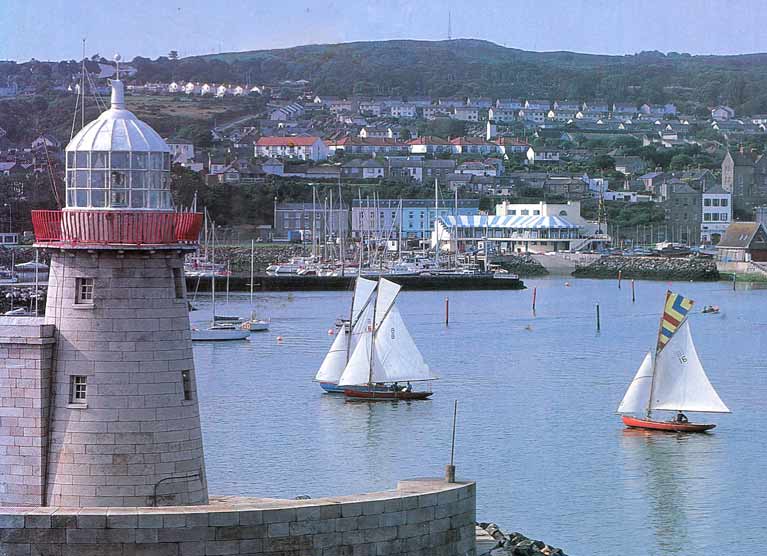 Howth in 1995, when HYC celebrated its Centenary. The clubhouse has since been extended to complete the curve of the “marquee roof”. Photo: Jaimie Blandford
Howth in 1995, when HYC celebrated its Centenary. The clubhouse has since been extended to complete the curve of the “marquee roof”. Photo: Jaimie Blandford
They missed the HYC Centenary in 1995, but they take such a refreshing delight in this place where they now sail that they see no reason why the 125th Anniversary of Howth Yacht Club shouldn’t be celebrated with the same enthusiasm. The rest of the membership have happily allowed themselves to be swept up in this fresh wave of zest in sailing, which will include a celebratory HYC Cruise-in-Company in the Irish Sea in June.
That said, both Lough Ree YC in celebrating their 250th, Lough Erne with their 200th and Howth with their 125th are giving due respect to the Royal Cork YC’s unique position. But while generally allowing that July is mainly Cork-focussed, they will be stepping up their home programmes to accommodate their members’ rising expectations, and an overview of 2020’s highlights across Irish sailing gives some flavour of this.
MAIN EVENTS OF IRISH SAILING 2020
April 16th – 19th Youth Nationals & Optimist Trials Howth YC
Already very much a major event, it is now even more so with the addition of the 29er to established classes including Laser Radial, Laser 4.7, Int 420, Int Topper and Optimist to provide a high octane regatta to get Howth 125 under way.
April 18th Irish Sea Offshore Racing Association first race
An organisation which skillfully tailors its programme to suit the realities of modern life, ISORA’s first race of 2020 is a coastal on the Welsh side at Pwllheli, then the following weekend there’s the inaugural coastal for the Irish side at Dublin Bay, and then on May 2nd the fleets from both sides of the Channel get together for the Dun Laoghaire-Holyhead Race along a course which has its origins in the 1860s or even earlier.
One of the ISORA highlights for 2020 will be the re-staging of the famous Dublin Bay to Cork Harbour Race of 1860 on 9th July, bringing the Irish Sea boats to the RCYC Tricentenary in a special event which has a points weighting of 1.2 in the ISORA championship. The annual season-long championship - in which Paul O’Higgins’ JPK 10.80 Rockabill VI is defending champion – concludes with the Pwllheli to Dun Laoghaire race on September 5th, favourably weighted at 1.3 points to encourage the fleet to stay keen to season’s end.
 Tarbert on Loch Fyne, where the Scottish Series has provided a successful hunting ground for many Irish boat
Tarbert on Loch Fyne, where the Scottish Series has provided a successful hunting ground for many Irish boat
May 22nd-25th Scottish Series
In 2019, this was a very happy hunting ground for Irish boats, with Andrew Craig’s J/109 Chimaera (RIYC) leading the charge to take the overall prize from Pat Kelly’s sister-ship Storm from Rush, while class wins were also recorded by Jay Colville’s First 40 Forty Licks from East Down and Jonny Swan’s Half Tonner Harmony from Howth, and there was a special award for John and Brian Hall’s J/109 Something Else (NYC)
May 29th – 31st Wave Regatta Howth YC
The main highlight of the many specials in HYC’s 125th Anniversary programme, this unique biennial mixture of old-style regatta, modern rock concert and 21st Century take on Howth’s time-honoured Lambay Race has something for everyone, while the eclectic collection of boats and classes taking it on makes life afloat as diverse as it is ashore – “Wave float, rave ashore” was 2018’s catch-phrase.
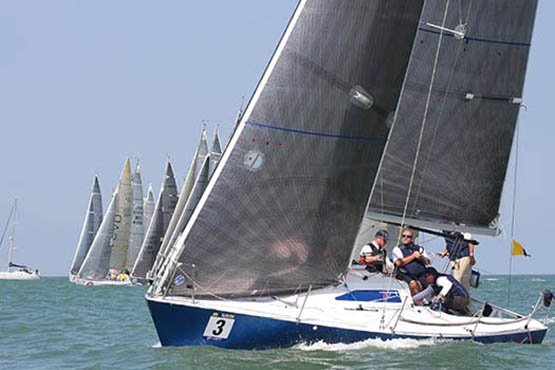 Dave Cullen’s Half Tonner Checkmate XV on her way to winning the Half Ton Classic Worlds in Belgium in 2018. Earlier that year, she had been overall winner of the inaugural Wave Regatta at Howth
Dave Cullen’s Half Tonner Checkmate XV on her way to winning the Half Ton Classic Worlds in Belgium in 2018. Earlier that year, she had been overall winner of the inaugural Wave Regatta at Howth
Somehow, even an overall winner was found, in Dave Cullen’s immaculate classic Half Tonner Checkmate XV. In 2020, she and the other four Howth Half Ton Classics will be building their campaigns towards the RORC-hosted Half Ton Classics Cup in Cowes (Checkmate XV is defending champion in this biennial challenge) from 26th to 31st July. It’s a measure of their enthusiasm that all five Howth-based Classic Half Tonners are planning to do the multi-championship Volvo Cork Week from July 13th to 17th, and then their roadies (sometimes the skippers themselves) will be busy to get all five to Cowes in the best spirit of Howth 125 and Cork 300.
May 30th – June 1st Clinkerfest Lough Ree Yacht Club
Lough Ree’s Bicentenary programme ashore will be inaugurated as early as January 4th 2020, and by April they’re sailing. But the scene afloat really gets into top gear with this intriguingly-titled event, which offers infinite possibilities. The elegant clinker-built Shannon One Designs may be the backbone of LRYC, but the likewise clinker-constructed Dublin Bay Water Wags are no strangers to sailing at the hospitable club, and when we add in other qualifying clinker classics such as the Mermaids, the IDRA 14s and the growing numbers of the vintage International 12s just for starters, we’re looking at a really fascinating three day regatta which could easily exceed its target of a hundred classic wooden boats.
June 10th to 14th - Sesquicentennial Regatta National YC
Two evenings and one day of racing is the celebratory programme outlined to celebrate the 150th anniversary of the National Yacht Club in Dun Laoghaire. Racing will be in association with DBSC and ISORA and include cruisers, one designs, dinghies & Wags. As befitting the 150th anniversary, NYC Regatta Director Con Murphy says it will be bigger than the traditional Saturday club regatta by being a multi evening/days event from 10-14th June with racing for keelboats on Thursday and Friday evenings as well as the normal racing on the Saturday. Dinghies will have racing on Friday evening and Saturday, Waterwags on the Wednesday and Friday evenings and ISORA boats on Thursday and Friday evenings and all day Saturday. For cruiser and keelboat classes, the races on Thursday evening will be run by DBSC per their standard Thursday courses and be scored in the regatta results.
 Classic Shannon One Design in a breeze. The elegant clinker-built hulls are expected to be flexible, and when sailed hard there’s a visible twist, while in a strong wind “they’d turn round and look at you”.
Classic Shannon One Design in a breeze. The elegant clinker-built hulls are expected to be flexible, and when sailed hard there’s a visible twist, while in a strong wind “they’d turn round and look at you”.
June 20th Round Ireland Race. Wicklow SC
It’s the 40th Anniversary of this biennial classic. And even here there’s no getting away from the long arm of the Royal Cork YC, for it was the first participation by Denis Doyle of Cork with his beloved Moonduster in the second race of 1982 that set this 704-mile challenge firmly in the Irish and international programme. The race has matured into a “must-do” for many sailors from home and abroad (it’s particularly popular with the French), and the winner in 2018 was the Dutch-origined Ker 43 Baraka GP chartered by Niall Dowling (RIYC) and navigated by the peerless Ian Moore to a win of stylish brilliance. For 2020 the gallant organisers in Wicklow SC are thinking in terms of 60 boats on the line, and they’re expected to include Paul O’Higgins JPK 10.80 Rockabill VI, which in her three seasons in his ownership has twice won the Dun Laoghaire to Dingle race and has also added the ICRA Nats and the ISORA Championship to her laurels, but the Round Ireland has until now been frustrating despite two challenges.
June 24th to 27th WIORA Championship Tralee Bay SC
When you’re north of the Blaskets on the mighty Atlantic seaboard, you have to create your own programmes, and this date best suited the men and women of the west, with the McCormack family of Foynes the defending champions.
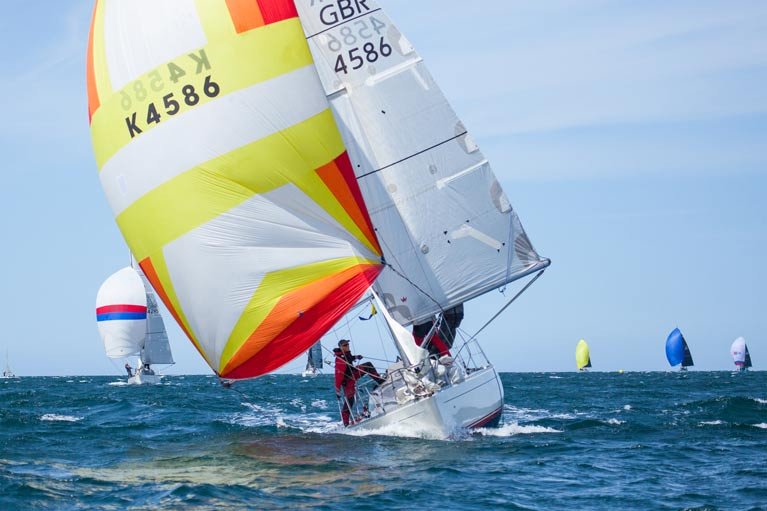 The Sigma 33 Impulz (C D & M Johnston) in Bangor Town Regatta 2018. The 2020 Edition will include the Sigma 33 Championship. Photo: Andrew Gallagher
The Sigma 33 Impulz (C D & M Johnston) in Bangor Town Regatta 2018. The 2020 Edition will include the Sigma 33 Championship. Photo: Andrew Gallagher
June 25th – 28th Bangor Town Regatta Royal Ulster YC
This combination of serious championships and traditional township regatta proved to be a winning formula when it was unveiled in 2018, and for 2020 they’re super-tuning a successful menu. It will include key races for the season-long RC35 Championship (in which Pat Kelly’s J/09 Storm of Rush and Howth is champion), and will also feature the peripatetic Sigma 33 Championship, which was a highlight of 2019’s Volvo Dun Laoghaire Regatta to celebrate 40 years of the Sigma 33 - the defending champion is from Scotland, Leaky Roof 2 from Cove SC sailed by Alan Harper and Kirsty & Eric Robertson.
July 4th to 11th Laser Radial Youth European Championship, Ballyholme YC
It’ll be busy in Bangor in late June and early July. They’ll have barely tidied up after the Bangor Town Regatta before the focus swings to Ballyholme YC and the massive challenge of staging the Laser Radial Youth Europeans 2020. It’s massive because fleet numbers can go stratospheric – 2019’s in Athens saw Spain’s Ana Moncada top the Girl’s Gold Fleet, while Karim Sofiana (France) was the boys’ champion in a total fleet of 252. The word is that Ballyholme is gearing up for 300-plus, even though this is a high-calibre championship with a restricted entry allocation.
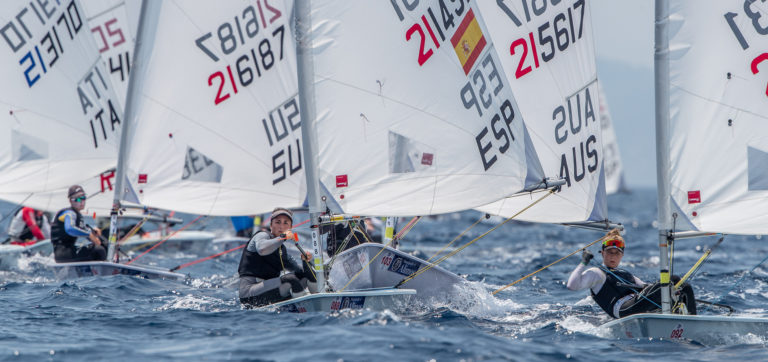 The Laser radial Youth Euros in 2019 at Athens attracted a fleet of 252 boats, with winners from Spain and France
The Laser radial Youth Euros in 2019 at Athens attracted a fleet of 252 boats, with winners from Spain and France
July 8th Cowes to Cork Race (Morgan Cup) RORC
The RORC are putting their full support behind the Cork 300 celebrations by bringing their fleet to Ireland through making their annual Morgan Cup contest a 324-mile Cowes to Cork Race, and giving it a 1.3 points weighting in their season-long championship. Yje Morgan Cup winner in 2019 was the J/109 Just So, raced two-handed by William McGough and Christian Jeffrey in a result which shows the possibilities of this significant element in the Cork300 celebrations.
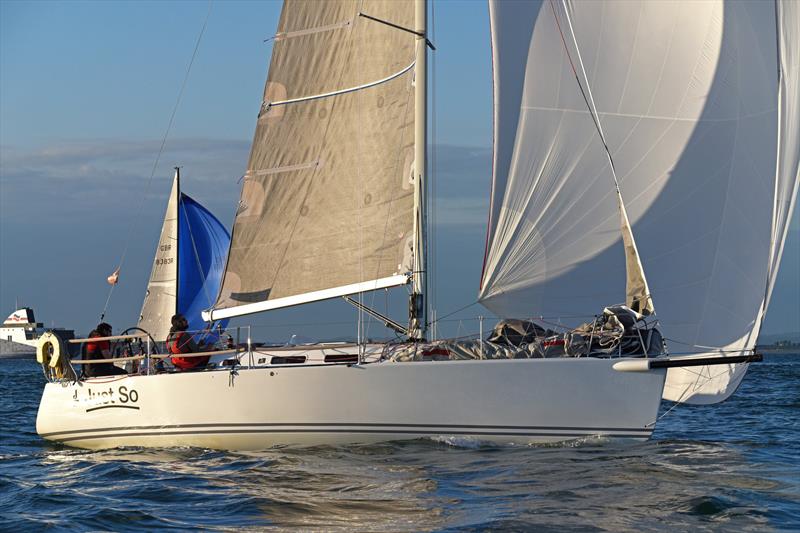 The J/109 Just So (William McGough & Christian Jeffrey) may have been in the Two-handed Division in the RORC’s 2019 Morgan Cup Race, but she won overall. Photo RORC/Rick Tomlinson
The J/109 Just So (William McGough & Christian Jeffrey) may have been in the Two-handed Division in the RORC’s 2019 Morgan Cup Race, but she won overall. Photo RORC/Rick Tomlinson
July 9th Dun Laoghaire to Cork Race, ISORA
This is the re-staging of the renowned contest of 1860, when 16 boats of many sizes – some of them enormous – raced from Dublin Bay to an extremely close light weather early-morning finish off the historic Royal Cork premises on the Cobh waterfront. Surely a “must-do” for anyone who wants to sail with the great yet friendly spirits of Irish sailing history.
With the two big feeder races completed, everyone is in Cork, and the best impression of what’s going to happen is to be found here:
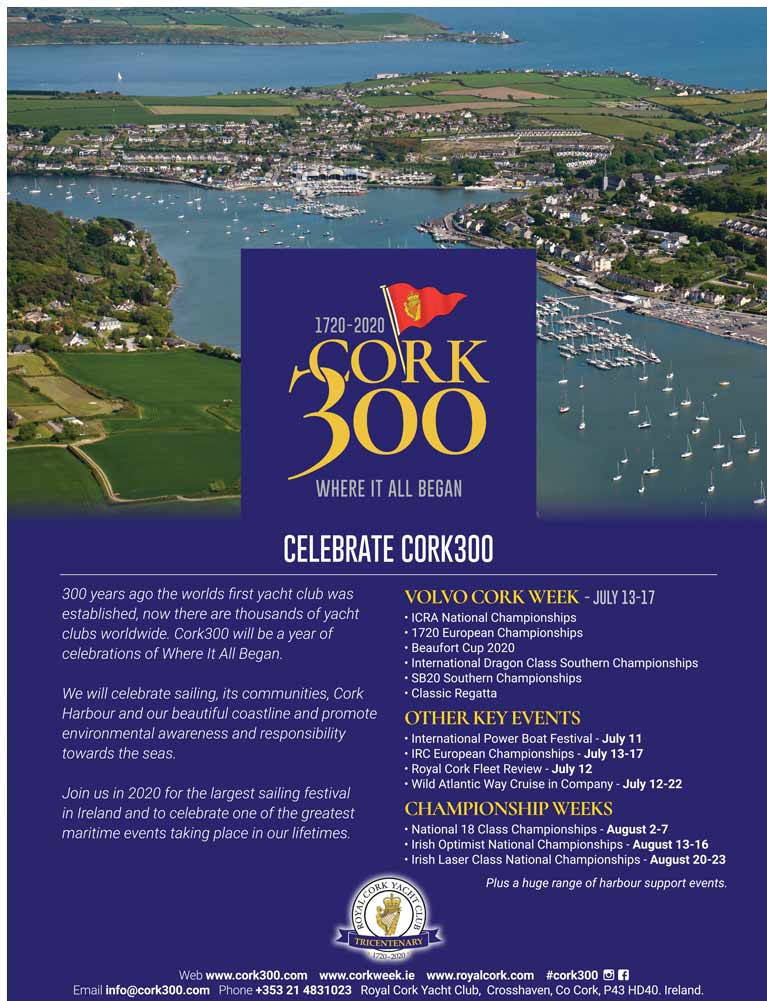
While the action in Cork continues until well into August by which time the dinghy fleets have taken over, after the Fleet Review of July 12th the many cruisers from several organisations will start slipping away down towards West Cork, and Glandore is poised to be their first port of call:
July 18th to 24th Glandore Classics Regatta Glandore Harbour YC
The presence of so many cruising clubs and association on the south coast thanks to Cork300 is expected to bring spin-off benefits in numbers to Glandore’s biennial boatfest, and not least of the attractions is that until much nearer the time, we simply don’t know which truly extraordinary historic vessel is going to steal the show.
July 18th – 19th Double Ree Lough Ree YC
In an era when hosting single-handers can easily provide impressive fleet numbers, for some years Lough Ree YC has been promoting a special Regatta aimed solely at two-handed dinghies, and under the umbrella of the Ree 250 celebrations, 2020’s will have a special edge.
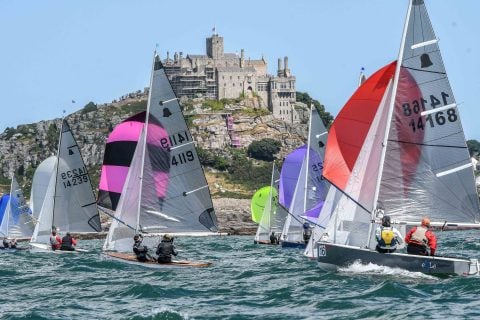 GP 14s racing below St Michael’s Mount in Mounts Bay in Cornwall in their 2018 World Championship in which Katie Dwyer and Michelle Rowley of Sutton Dinghy Club were timed at 10.5 knots.
GP 14s racing below St Michael’s Mount in Mounts Bay in Cornwall in their 2018 World Championship in which Katie Dwyer and Michelle Rowley of Sutton Dinghy Club were timed at 10.5 knots.
July 26th to 31st GP 14 World Championship Skerries SC
In Ireland, the GP 14 is not so much a successful Class Association as a benign force of nature, through which they do things their own successful way. The 2020 Worlds at Skerries will be a large turnout high-stakes event. It’s biennial, and in 2018’s in Mounts Bay in Cornwall with a fleet of 119, the winners were England’s Mike Senior and Chris White with Irelands Ross Kearney second. But in 2016 in Barbados, the winner was Shane McCarthy of Greystones, currently on a roll by taking the 2019 Irish Open Nationals at Skerries in August 2019. It’s typical of the enthusiasm of the Association that somehow they’re able to tell you not just who wins the Worlds, but who recorded the best figures in speed bursts, with Neil Marsden and Derek Hill of Fleetwood tops at 10.9 knots, while Ireland’s own Katie Dwyer and Michelle Rowley of Sutton Dinghy Club clocked 10.5.
July 26th – August 8th. Olympic Games Enoshima, Japan
We have a place in the Laser Radials thanks to Aisling Keller of Lough Derg YC, but the sailor filling it is still open to competition among four helms in the first four months of 2020.
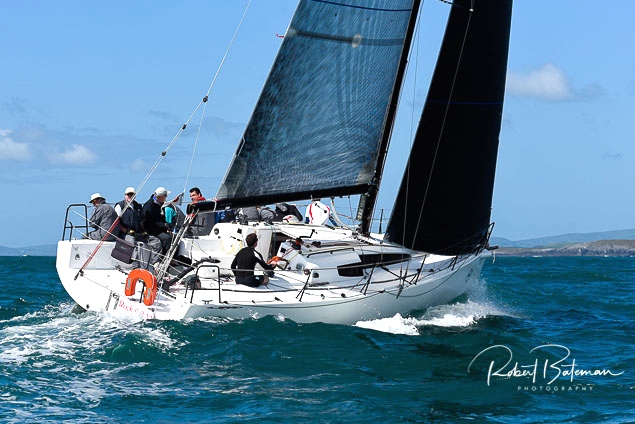 Paul O’Higgins’ JPK 10.80 Rockabill VI (RIYC) racing in Calves Week at Schull. Photo: Robert Bateman
Paul O’Higgins’ JPK 10.80 Rockabill VI (RIYC) racing in Calves Week at Schull. Photo: Robert Bateman
August 4th to 7th Calves Week Schull Harbour SC
Fun racing with a serious edge - it sounds like an internally contradicting formula, but among the sublime sailing water of Carbery’s Hundred Isles, it certainly works
August 4th to 6th RS200/RS 400 Nats. Rush SC
Late July and early August will by hyper-busy on the Fingal coast as the bubbles settle after the GP 14s Worlds at Skerries, and clubs close to the southward leap to life
August 4th to 6th J/24 Nationals Howth YC
The J/24 is very much the boat of choice among a certain set, and many who sail it as it revives in Ireland are to be found on other boats as well. Defending champion is Headcase helmed by Cillian Dickson of Lough Ree and Howth, sailing with co-owners who come from all over the country.
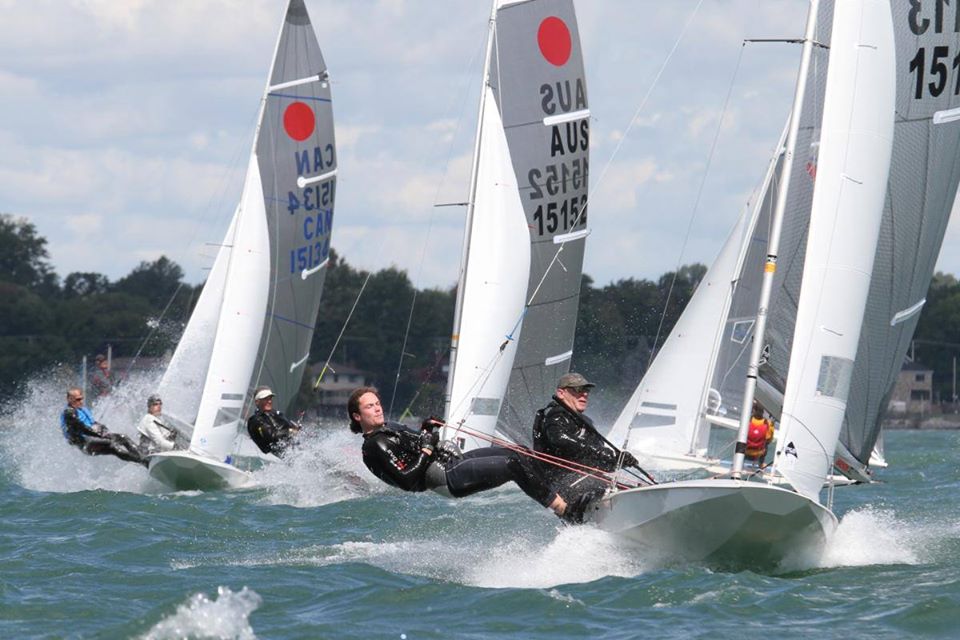 The 2019 Fireball Worlds in Canada, in which the first four places went to four different nations. The 2020 Worlds will be at Howth from August 6th to 14th.
The 2019 Fireball Worlds in Canada, in which the first four places went to four different nations. The 2020 Worlds will be at Howth from August 6th to 14th.
August 6th to 14th Fireball Worlds Howth YC
Another major in HYC’s 125th-year celebrations, this lengthy schedule includes the Fireball Irish Nationals and the pre-Worlds. The 2019 Worlds were in Canada at the friendly Point Claire YC in Montreal, and the winners were Ian Dobson & Richard Wagstaff (UK), while Silver went to Heather McFarlane & Chris Payne of Australia with France’s Ludovic Collin and Remy Thuillier taking the Bronze, fourth going to Switzerland’s Claude Mermod & Ruedi Moser.
August 14th to 16th Cruinniu na mBad Kinvara
The great Kinvara celebration of the maritime culture of the west and the magnificent traditional boats which sail there is now in its 41st year and still going strong, developing intriguing new facets with each passing year.
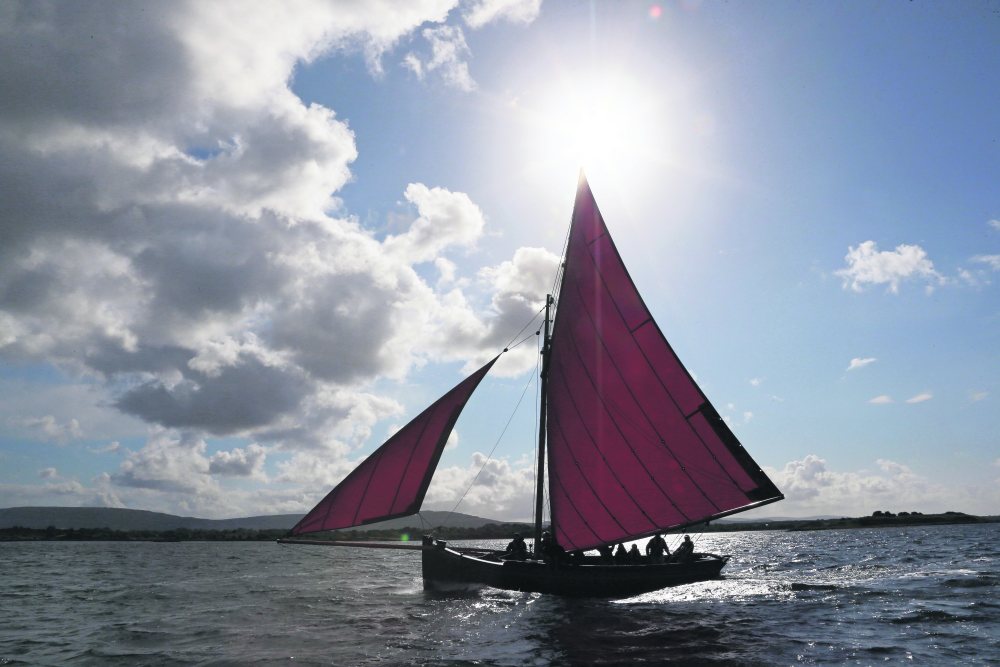 Kinvara bound – a majestic Galway hooker heads for Kinvara and Cruinniu na Mbad – the Gathering of the Boats.
Kinvara bound – a majestic Galway hooker heads for Kinvara and Cruinniu na Mbad – the Gathering of the Boats.
August 29th to 30th BJ Marine Taste of Greystones Regatta Greystones SC
Time for Down Home Time. The boats of south Leinster have returned from their voyaging and racing adventures, the Autumn is upon us, and Greystones awaits them with hospitable abundance
September 3rd to 11th Dragon Gold Cup Kinsale Yacht Club
One of European sailing’s most historic trophies brings an international fleet of the elegant and timeless Dragons to one of Ireland’s high-quality sailing venues. Winner in 2019 was Portugal’s Pedro Andrade racing at Medemblik in The Netherlands.
September 5th James C Eadie Cup Race: Pwllheli-Dun Laoghaire ISORA
We’ve mentioned it before, it deserves mention again as the Irish Sea programme draws to a close in a race which, in 2019, saw the ISORA Annual Championship decided in its last few miles
September 18th to 20th SB20 Nationals Lough Ree YC
The last big event of the LRYC 250th, in 2019 the SB20 representative Michael O’Connor went on to become the All-Ireland Champion racing in Flying Fifteens, so there’s an extra edge here.
September 26th to 27th All-Ireland Junior Championship
The venue is still to be confirmed, but the date is definite. 2019’s Junior Champion Chris Bateman turned 18 in September, but in any case he’s now more interested in 49er racing
October 3rd to 4th All-Ireland Helmsman’s Championship Royal Cork YC
A fitting conclusion to the extraordinary Cork 300 celebrations an the 2020 season. It rounded out the Quarter Millennial celebrations back in 1970, and five of the six finalists from that are still happily with us, so we can expect something very special.
 The Autumn closes in, and North County Wicklow is ready with the hospitality for the BJ Marine “Taste of Greystones” Regatta hosted by Greystones Sailing Club.
The Autumn closes in, and North County Wicklow is ready with the hospitality for the BJ Marine “Taste of Greystones” Regatta hosted by Greystones Sailing Club.
Irish Sailing Needs to be More Upbeat About its Future
Here in the Sailing on Saturday verbiage production complex in a hidden bunker under a nameless hill off an un-named coast of Ireland, all this maundering-on about a gloomy future for sailing in general and Irish sailing, in particular, passes us by completely. For we’re too busy dealing - with only moderate success - with a hyper-busy and continuous throughput of interesting and usually good news about sailing things that interest us, and achievements by sailors that we admire.
Thus of late, our attention has been particularly piqued by Guy and Jackie Kilroy’s restoration of the 1896 classic cutter Marguerite which they successfully commissioned from the multi-talented Larry Archer. And as we write this, it’s all over the sailing news that the equally multi-talented Laura Dillon has just won a race in the Classics Division of the 190-strong International Dragon fleet (190 boats still as keen as mustard to a 1929 design - what can one say?) in the 90th Anniversary Regatta in San Remo, and all that just a few days after she came third overall in the British Open J/70 Championship.
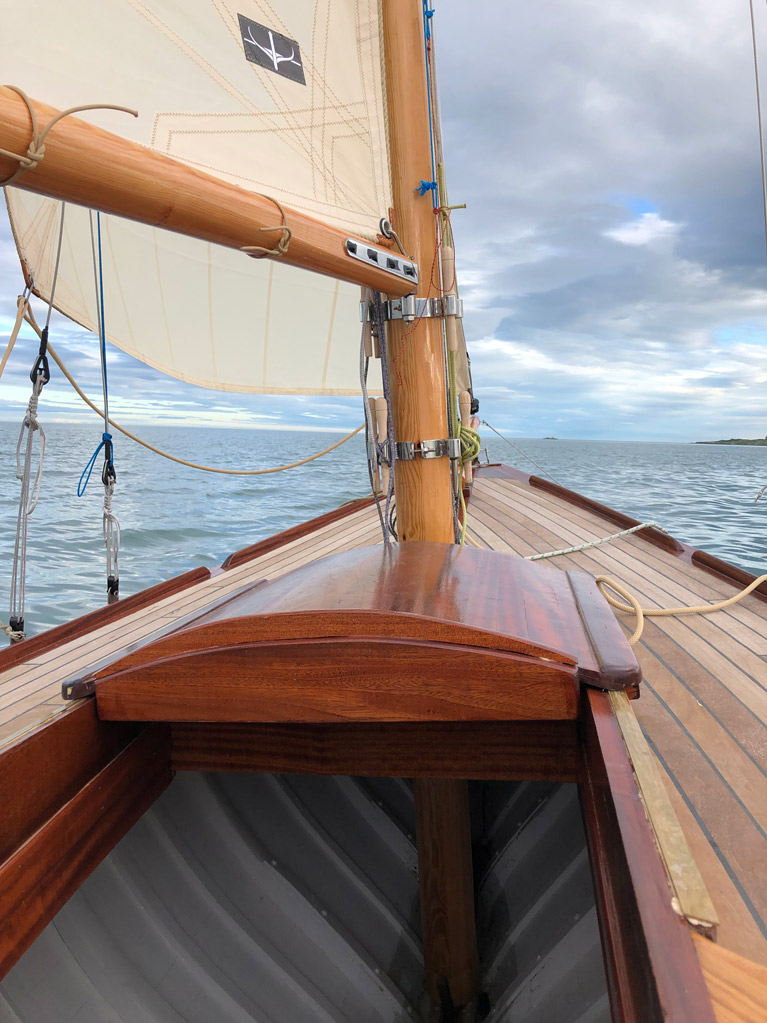 The latest addition to Dun Laoghaire’s growing classic boat flotilla - aboard the restored 1896-built Marguerite (Guy & Jacky Kilroy) in Dublin Bay in September. Photo: Ian Malcolm
The latest addition to Dun Laoghaire’s growing classic boat flotilla - aboard the restored 1896-built Marguerite (Guy & Jacky Kilroy) in Dublin Bay in September. Photo: Ian Malcolm
Laura Dillon is, of course, the only woman who has ever won the All-Ireland Helmsmans Championship which - when she did it in 1996 - was hailed as a great leap forward, the breaking of the glass gender ceiling at the top of our sport. Yet she remains the only woman sailor to have done it.
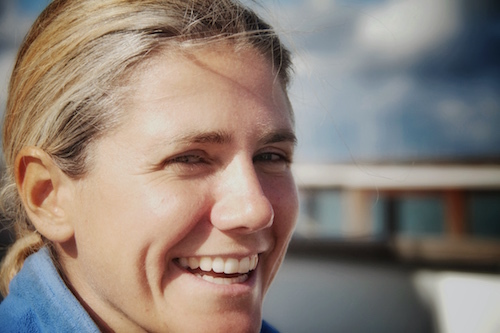 Top helm Laura Dillon, still the only woman to have won the All-Ireland Sailing Championship.
Top helm Laura Dillon, still the only woman to have won the All-Ireland Sailing Championship.
So how do we get more women up there too? For only she and Annalise Murphy have remained at the top of our sport for a long and consistent time. The simple answer is find another Laura Dillon, for she is that rare thing, a true sailing polymath. Like Harry Cudmore in his prime, she can step aboard any boat and make it go faster. And maybe most importantly of all, she conveys a sense of enjoyment and interest which says everything about the popular potential of sailing without having to bellow it from the rooftops. But she does it as a sailor first, so much so that the fact that she’s a woman doesn’t really enter the discussion.
That said, getting more women involved as sailors rather than sailor-supporters is an area which needs exploration, for our national body Irish Sailing has to recognise that, in some areas, participation numbers are dropping. And throughout the country, you’ll always find somebody in some club who is wondering about whether or not the established model of the Irish yacht and sailing club is truly relevant any more.
Irish sailing was booming to such a lunatic extent during the growth towards the Celtic Tiger years that at one stage we were fielding three different three-boat teams for the biennial Commodores Cup series in the Solent, billed as the World Championship of offshore racing. Not only were we fielding thee different teams, but it was such a crazy time that wearing the green jersey was meaningless – the Irish teams were racing against each other with even more determination than they were racing against the teams of other nations. And to top it all out, Ger O’Rourke of Kilrush then became overall winner of the 2007 Rolex Fastnet Race with his Cookson 50 Chieftain, undoubtedly the highest of the high points.
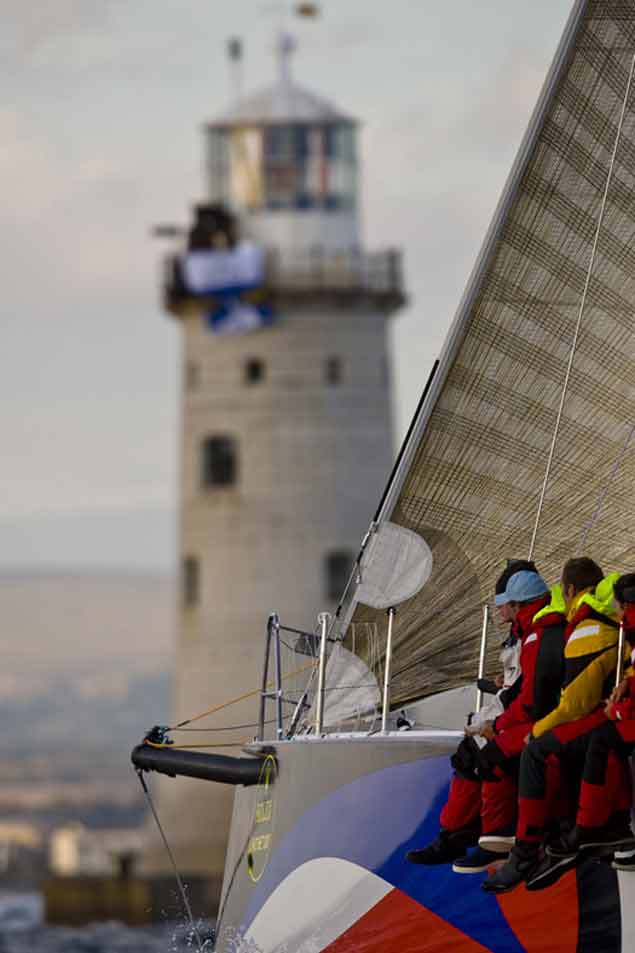 The high point of the boom years of sailing – Ger O’Rourke’s Cookson 50 Chieftain crosses the finish line at Plymouth to become overall winner of the Rolex Fastnet Race 2007. Photo: Rolex
The high point of the boom years of sailing – Ger O’Rourke’s Cookson 50 Chieftain crosses the finish line at Plymouth to become overall winner of the Rolex Fastnet Race 2007. Photo: Rolex
It all ended in tears not because of a clash of loyalties among our Commodore’s Cup teams, but because the national economy fell off a cliff in 2008. It took time for this to become evident in some areas of activity, but in the world of high-end privately-funded offshore racing, the effect was almost instantaneous. Top boats and top owners simply disappeared like snow off a ditch.
In time – jig time in some cases - it spread steadily down through every aspect of sailing until the National Authority - the Irish Sailing Association as it then was - had to implement a ruthless cost-cutting scheme in many of its activities, followed by the 2014 introduction of a five year plan based on a Strategic Review to keep the Association in good health. As for the clubs - which had been thriving in an almost dangerous fashion - they’d to make their own arrangements for survival. And though there were some very close squeaks, by and large we still have the same clubs, and indeed some new ones, as we had in 2008.
Meanwhile the Irish Sailing Association re-branded itself as Irish Sailing, and as CEO Harry Hermon has put it, the 2014 Five Year Plan was basically about putting in place and maintaining the essential pillars of the national sailing administration.
This has been largely successful, but it has been happening in a rapidly changing leisure environment which challenges one interpretation of Irish Sailing’s slogan of “Sailing - a Sport for Life”. Many people now approach their leisure interests on a sort of Tasting Menu basis, trying one thing one weekend and another the next. Claiming something is a sport for life is not necessarily a winning USP. And under-pinning it all these days is a very strong emphasis of doing it in a family-together way.
This is blush-making for those of us in the old school of sailing, who used to bid farewell to the wife and kids every Friday or even earlier, either with dinghy in tow down the road, or aboard an offshore racer, with every intention of being absent and totally boat-absorbed until Sunday evening or Monday morning.
That has all changed. Dare one say it, but to some extent maybe we can “blame” it on the availability of divorce, of which in Ireland – let it be said – we are still mercilessly unenthusiastic. Yet not so many years ago, many of us can remember completely estranged couples who led parallel lives within the same household, but the weekend escape in different directions - whether it be for golf or sailing or whatever – was the only thing which kept the situation tolerable.
In those days, the expression “Fun for All the Family” was considered something of a quaint joke, but nowadays it’s an essential first requirement for any leisure activity which wants to expand its base – or even maintain its position – in an increasingly challenging market.
 David O’Brien, Admiral of the Royal Cork YC from 2002-2004, is chairing Irish Sailing’s Steering Committee for the Strategic Review to create the Five Year Plan for 2020-2025.
David O’Brien, Admiral of the Royal Cork YC from 2002-2004, is chairing Irish Sailing’s Steering Committee for the Strategic Review to create the Five Year Plan for 2020-2025.
So for the month of October, Irish Sailing has been convening research groups – open to all - at key locations throughout the country, guided by a Steering Committee chaired by former RCYC Admiral David O’Brien, with Harry Hermon as convenor and the members including Fiona Bolger of Baltimore SC, former Howth Yacht Club Commodore Brian Turvey, and PR guru and sailor Sarah O’Connor. Their mission is to find out how our sport really is doing at the grassroots, and where it might go, with professional guidance from sports administration consultants Sarah O’Shea and Lisa Clancy.
The sessions have been in Cork, Clare, Mayo, Greystones and Howth, on a two-hour schedule with focus groups dealing with specific areas on four topics apiece, concluding with a synthesis. You might well think two hours is a very long time for a distinctly Autumnal night, but we could have comfortably used another hour, and the ideas and information flowed thick and fast in the Howth assembly this week, which was attended by no less than nine different clubs – not just the local ones in the Greater Dublin area, but folk from Dunmore East in Waterford and Mullaghmore in Sligo too.
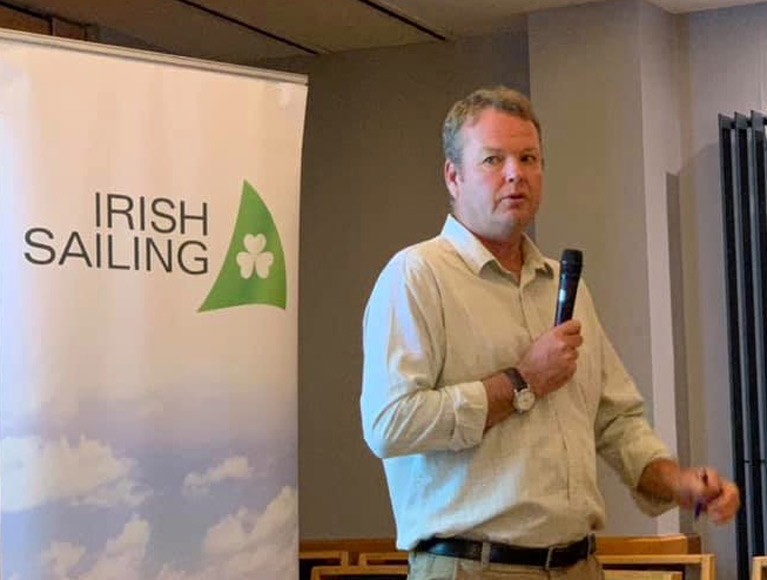 Harry Hermon, CEO of Irish sailing, speaking at this week’s meeting in Howth. Photo: Brian Turvey
Harry Hermon, CEO of Irish sailing, speaking at this week’s meeting in Howth. Photo: Brian Turvey
In an era when club ownership of boats is increasing in order to broaden the overall appeal of the club “product”, the basic and often brutal cost of boat ownership naturally loomed large. At our table, Richard Colwell, Commodore of ICRA, quipped that: “Everyone wants to be a boat owner on Wednesday night, but then be clear of it again until the next race on Saturday”. That just about sums it up, but of course the problem is that when a club has a varied fleet available for charter – the Royal St George, for instance, now owns upwards of 60 boats, they’re mostly small ones but they’ve J/80s and 1720s and a cruiser-racer donated by a former Commodore too – the imminent arrival of good weather can see a rush to take out bookings.
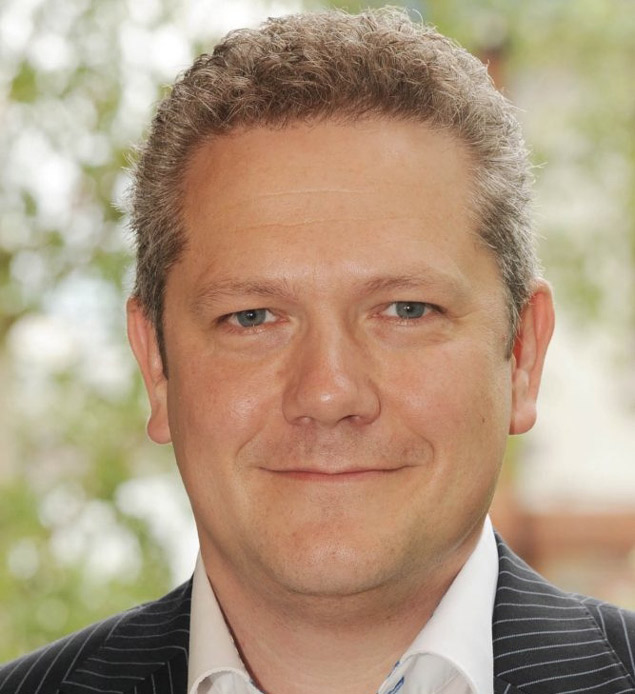 Richard Colwell, Commodore of the Irish Cruiser-Racing Association, commented this week that everybody wants to be a boat-owner when a race is on - it’s the in-between periods which are difficult……
Richard Colwell, Commodore of the Irish Cruiser-Racing Association, commented this week that everybody wants to be a boat-owner when a race is on - it’s the in-between periods which are difficult……
And then of course, no matter who owns the boats, there’s always maintenance and winter storage. The reality is that in Dublin in particular, the marine industry infrastructure bears no proper relationship to the demands which can arise when, for instance, a World Championship is being staged, while the total lack of shed space anywhere near the waterfront means that the Royal St George YC keep their flotillla of J/80s in the winter in the corner of a warehouse in Edenderry. For those who don’t know the Irish Midlands, Edenderry is about halfway to Athlone, and a lot longer when you add in the inevitable M50 congestion.
All these problems relate to sailing being a vehicle sport, and don’t even begin to address the way it is perceived as an activity, and how accessible or interesting it is to the general public. The brutal fact of the matter is that unless somebody has been drowned or an Olympic medal has been won, sailing scarcely registers on the public or government radar at all, and one nugget of useful thinking which emerged from our session is that it is up to sailing to look after itself, and not expect the authorities – whomsoever they may be – to provide the necessary vision from above.
Thus when the old chestnut about sailing being officially on the school curriculum in France came up, and why can’t we hope for that in Ireland, it was pointed out that in many places in Ireland it is happening already, without any fancy directorate being handed down by the Mandarins of the Department of Education. The local schools and sailing club just get together and get on with it, but because it involves ordinary healthy active schoolchildren taking part in a sport which they find interesting and in which they cause no trouble to anyone else, it’s Good News and therefore Not Really News At All.
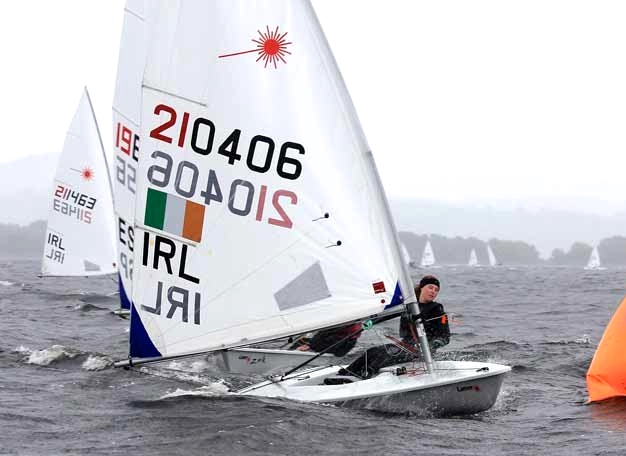 Laser Radial champion Aisling Keller leading the fleet at Dromineer, where she was introduced to sailing thanks to a locally-organised link-up between her school in Nenagh and Lough Derg YC.
Laser Radial champion Aisling Keller leading the fleet at Dromineer, where she was introduced to sailing thanks to a locally-organised link-up between her school in Nenagh and Lough Derg YC.
This, in turn, led to a useful exchange about how helpful it can be when clubs interact directly with each other, not just through the long-established Reciprocal Membership schemes, but in getting on with it, and organizing events up to international level. Thus the successful Galway Bay Sailing Club Cruise-in-Company to Lorient in Brittany in July was organised directly between GBSC and the Yacht Club de Lorient, which sent participating boats to Galway to cruise back with the Irish contingent. Apart from a bit of communication help from the French consul in Galway, it was all done directly inter-club, thereby minimizing the layers of bureaucracy, and it succeeded through a very welcome lightness of touch and mutual goodwill.
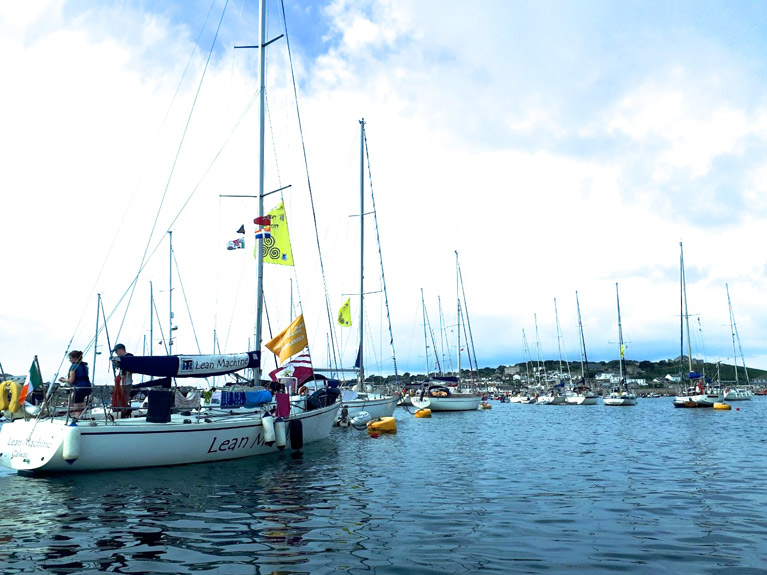 The Galway Bay SC fleet in Hughtown in the Isles of Scilly during their Cruise-in-Company to Lorient in Brittany in July, which was organized directly as an international inter-club event involving GBSC and Yacht Club de Lorient
The Galway Bay SC fleet in Hughtown in the Isles of Scilly during their Cruise-in-Company to Lorient in Brittany in July, which was organized directly as an international inter-club event involving GBSC and Yacht Club de Lorient
Thus if clubs are concerned for their own future, they need to become self-reliant and interact dynamically with their local community. But the official authorities in that local community have in their turn to realize that the bricks-and-mortar establishments which are traditional yacht and sailing clubs are operating in a very changed and challenging environment from the situation when they were built. They have to become much more commercial in their approach to promoting sailing on a businesslike basis – an approach strongly advocated by HYC Commodore Ian Byrne - and the existing planning laws may no longer be relevant to the reality of sailing and club life in the 2020s and beyond.
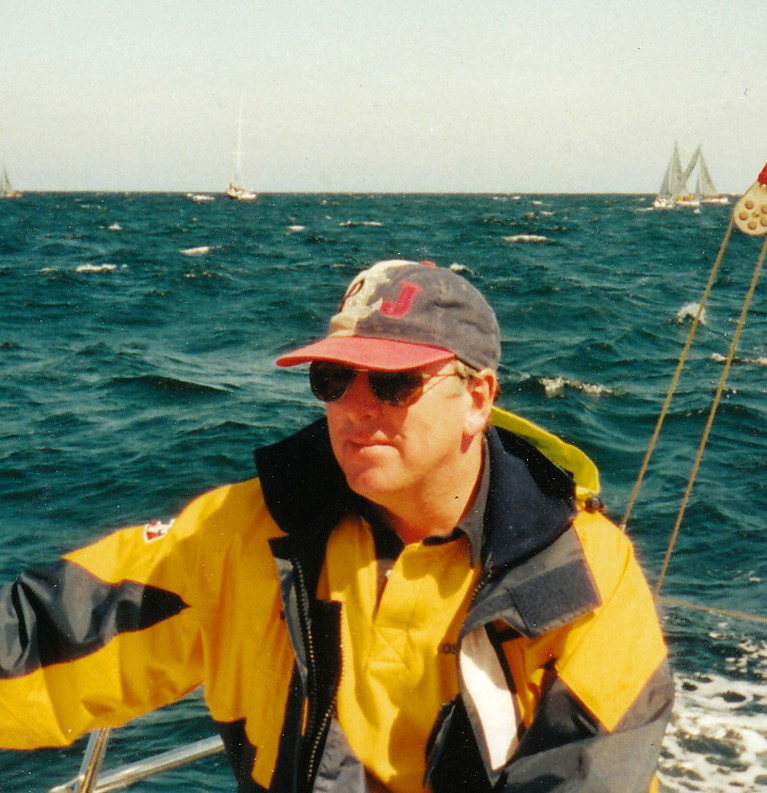 Ian Byrne, Commodore of Howth YC, racing his Sunfast 3200 Sunburn, while he also has a part share in a 112-year-old Howth Seventeen. He is firmly of the opinion that in today’s recreational climate, Ireland’s yacht clubs have to be more commercial in their approach to the many services they provide.
Ian Byrne, Commodore of Howth YC, racing his Sunfast 3200 Sunburn, while he also has a part share in a 112-year-old Howth Seventeen. He is firmly of the opinion that in today’s recreational climate, Ireland’s yacht clubs have to be more commercial in their approach to the many services they provide.
Just how much consideration all this receives from the new Irish Sailing Five Year Plan we’ll learn at the organisation’s AGM next March, when the outcome of this latest Strategic Review will be unveiled. Certainly, something we hope will receive due acknowledgement is the key role played by Ireland’s remarkable class associations. It mustn’t be allowed to pass notice that at last weekend’s All-Ireland Helmsman’s Championship, the winner – Michael O’Connor – came from the strong SB20 Association which also provided last year’s winner, Peter Kennedy, while third-placed was Shane McCarthy of the GP14s, whose Irish class association is so strong it’s a force of nature.
Clearly, there are many factors involved in what might be done to add to sailing’s appeal, while retaining what is already very good. Irish Sailing are looking for thoughtful input into our sailing future, and you can oblige them here
Make Sailing Simple Again – Some Committee Boat Starts Can Work Against Racing Enjoyment
Our header photo this week may not be the greatest in terms of clarity and technical brilliance, let alone jaw-dropping drama writes W M Nixon. But it tells us much about our peculiar sport of racing under sail, that two genuine and experienced sailing enthusiasts could examine this photo in detail and argue for hours about whether it is a Good Thing, or a Travesty of Sporting Justice.
It shows the Dublin Bay 25 class making a start through the mouth of Dun Laoghaire Harbour, which would have been Kingstown when the image was taken, as it’s probably pre-1914. But even were it in the 1920s or ’30s, many of the locals – including, one would think, practically everyone on these yachts - continued to call it Kingstown even though it had officially reverted to Dun Laoghaire in 1920, meaning that it had been Kingstown for just 99 years.
Be that as it may, it shows a classic summer’s day - probably a Saturday afternoon, though they had racing on some weekday afternoons too in the GODs (the Good Old Days) – and an easterly sea breeze is making as the 25ft LWL class, the aristocrats of the Dublin Bay One Design scene and the J/109s of their time, get their race under way.
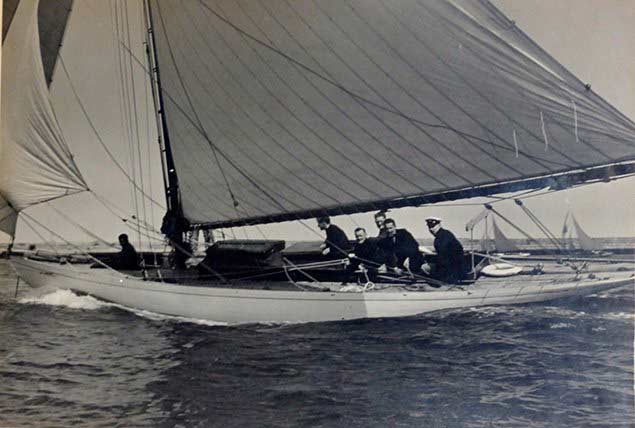 The J/109s of their day – the Purcell brothers’ DB 25 Acushla racing on Dublin Bay in 1938. An early owner was the legendary international tenor John McCormack, and Macushla was one of his most popular songs
The J/109s of their day – the Purcell brothers’ DB 25 Acushla racing on Dublin Bay in 1938. An early owner was the legendary international tenor John McCormack, and Macushla was one of his most popular songs
It may well be that their actual start was made in-harbour from a mark boat off the waterfront for the convenient viewing of the many members and their guests in the distinguished clubhouses (who would have observed proceedings for about four minutes as it was otherwise interrupting their lunch, but never mind). Thus it might be said that in accessing Dublin Bay through the harbour mouth, they were getting two starting lines for the price of one.
But either way, the last thing on anyone’s mind was the thought that people should go to much trouble – or indeed any trouble whatever – to provide a starting line which was at exactly 90 degrees to the basic wind direction. On the contrary, the thinking at virtually all sailing centres was that you should get the boats away as quickly and conveniently as possible from a start line near their moorings, and finish them in similar style. For in those pre-auxiliary-engine days, finishing at some distance from home with the wind failing was a big turn-off in every sense of the term, and it was certainly bad for club racing’s popularity.
Anyway, that header photo, which is such a long up the page by now that we’ll show it again, would seem to suggest that the boat on the left – no 2, Punctilio which was the last DB25 to leave Dun Laoghaire, she was here until the 1970s – is well set up, as they’re probably racing towards a first mark in mid-bay. She’s nicely on a closer-than-close reach but not actually hard on the wind, she’s just hitting the edge of the seaward-going ebb which will sharpen the breeze and enable her to sail at the optimum angle, and she looks to have freed herself from getting any dirt from the group close under the east pier.
 Here’s that start again for further examination
Here’s that start again for further examination
But don’t dismiss them entirely. The boat right under the lighthouse may be carrying her way with limp sails through a small calm spot. But within seconds she will be getting a benefit from the mini tide rip which swirls round the pier end, and suddenly her overall position could be transformed.
For in the GODs, the boat which has had the best start was the boat which was best placed after about a mile of racing. And who knows, but it might even be the boat in the foreground, No 1 which could either be Whisper built in 1898 by local shipwright J E Doyle, or it could be Fodhla built in 1903 also by J E Doyle.
For Fodhla was built for the Viceroy, the Earl of Dudley and the nascent 25ft class were so chuffed that Himself up in The Park was getting one of the boats (it was a surprise present from his wife) that they decided Fodhla should also be No 1. Only in Dublin Bay would they have two No 1s, while they never ever had a No 13.
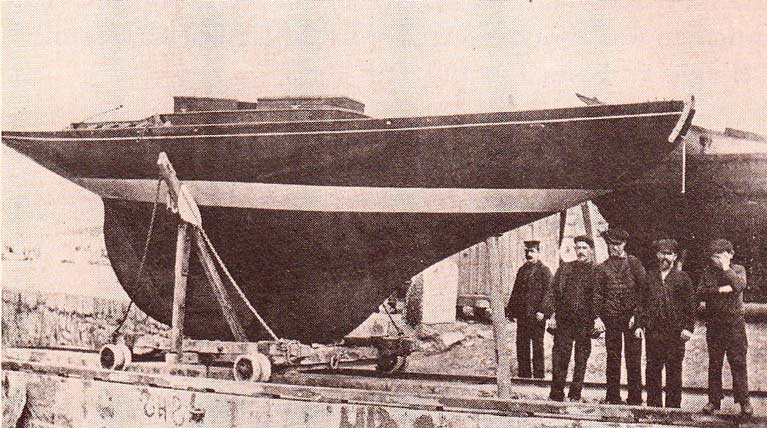 The new Fodhla ready for launching by builder J E Doyle into the Coal Harbour in what was then Kingstown in 1903. As the owner-to-be was the Viceroy, the class association caused eternal confusion by making her No 1 when they already had a No 1, built in 1898. Photo courtesy DBSC.
The new Fodhla ready for launching by builder J E Doyle into the Coal Harbour in what was then Kingstown in 1903. As the owner-to-be was the Viceroy, the class association caused eternal confusion by making her No 1 when they already had a No 1, built in 1898. Photo courtesy DBSC.
Anyway, Fodhla or Whisper or whatever is going like a train as she carries a private puff of breeze from within the harbour, but you’ll notice that her racing flag atop the jackyard tops’l suggests she is reaching, yet they already have her trimmed for the wind being well ahead of the beam, in anticipation of the significantly different direction outside.
Or it could be we’re flattering No 1’s crew? Maybe they’ve been surprised by this sudden puff from abeam or even slightly aft of it. But as it’s only going to last for a few seconds until they get into the basic breeze in the bay, it’s hardly worth their while adjusting the four different sheets which the complex rig of the DB25 requires, and it’s only going to cause confusion with the sister’s son, young Willie, who is trying to make himself comfortable in the sunshine on the lee deck, and fell overboard last time out, costing them a couple of places……
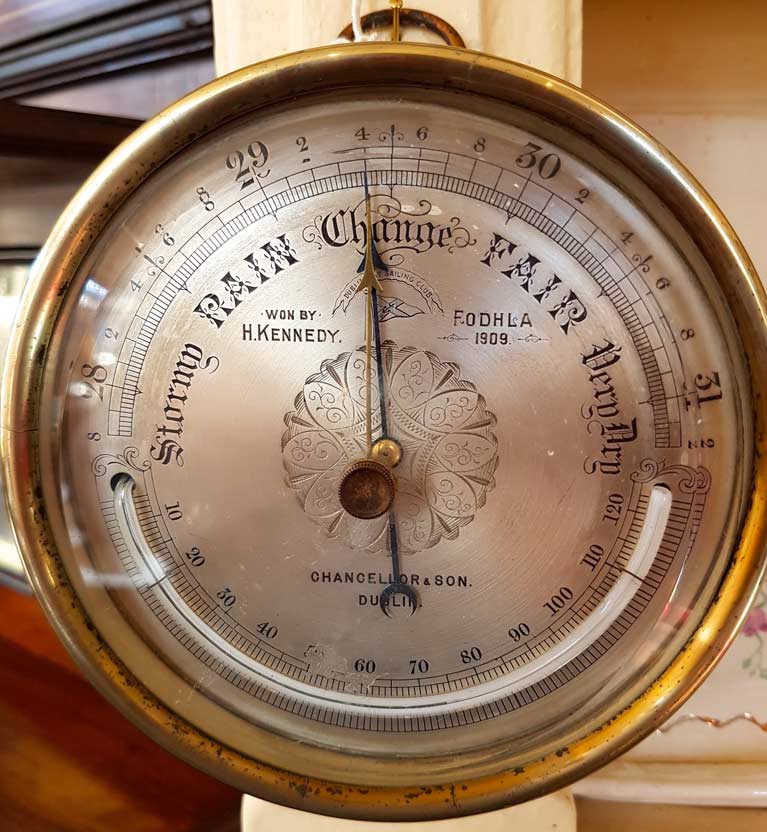 Fodhla was only briefly in the ownership of the Viceroy – by 1909 she was winning races for one H Kennedy, as this DBSC prize barometer from Vandeleur Antiques of Kilrush reveals.
Fodhla was only briefly in the ownership of the Viceroy – by 1909 she was winning races for one H Kennedy, as this DBSC prize barometer from Vandeleur Antiques of Kilrush reveals.
Be that as it may, we’re assuming one of our experienced observers is a sailor who enjoys racing which is as much an interaction with coastal features and local quirks of sea and weather as it is with the straightforward achieving of boat speed in clear relatively tide-free water, and he or she sees this start as a delightful challenge.
But equally we assume the other is a purist whose highest ideal is Olympic sailing in waters as interference-free as possible, with courses of a very set type with a starting line virtually at 90 degrees to the wind, which must be of minimal strength and steady direction, racing round marks well clear of any land influence with minimal and preferably no tide, and putting the emphasis on windward-leeward courses in which the crews are always busy busy busy. He or she, therefore, sees this start as a lazy luck-reliant shambles.
 The beau ideal of a modern start, far at sea and dead to windward, with an extra mark boat at mid-line set back a very few feet to keep the sighted line in order
The beau ideal of a modern start, far at sea and dead to windward, with an extra mark boat at mid-line set back a very few feet to keep the sighted line in order
Inevitably, in an era when public awareness of sailing just about extends to Olympic medals and no further, the Olympic disease is spreading down to every level of our sport. Characterful starting huts on the end of piers or on picturesque shoreside seapoints, both with eminently sensible transit markers setting the line, are discarded in favour of Committee Boats, mark-laying RIBs, and a general support cast of dozens of pious folk including, God help us, umpires…...
"the Olympic disease is spreading down to every level of our sport"
Even back in the 1990s, it was sometimes at the stage where there seemed to be more people on the management side than were actually racing the boats. But the 1990s being the final years of that prelapsarian era before 24/7 electronic communication meant that you now never knew when you actually have time off, even though I was churning out verbiage at a ridiculous rate for many printed publications with the odd book to make things truly manic, deadlines meant that was it - job done and goodbye, you were all clear, and some civilised diversion could be planned without a thought for what should be going onto some ever-active communication screen.
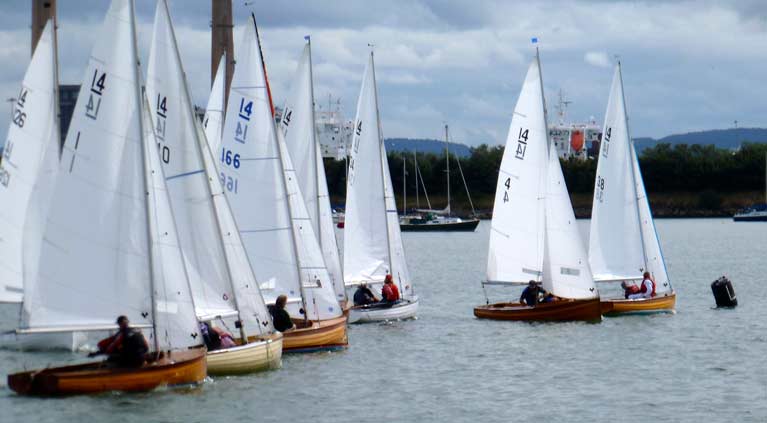 A spectator-friendly start for the IDRA 14s at Clontarf for their 70th Anniversary Race in 2016 in an area which dries out at low water. The line had been set from the shore to give a slight disadvantage to starboard tack boats, but a sudden backing of the light breeze accentuated this. Nevertheless the start proceeded, and while Andy Sargent in Dusk (no 4) has pulled off the port tack start, Gerry Sargent in Starfish is just able to make the pin on starboard, and he went on to win with Dusk second. Photo: W M Nixon
A spectator-friendly start for the IDRA 14s at Clontarf for their 70th Anniversary Race in 2016 in an area which dries out at low water. The line had been set from the shore to give a slight disadvantage to starboard tack boats, but a sudden backing of the light breeze accentuated this. Nevertheless the start proceeded, and while Andy Sargent in Dusk (no 4) has pulled off the port tack start, Gerry Sargent in Starfish is just able to make the pin on starboard, and he went on to win with Dusk second. Photo: W M Nixon
So anyway, after one particularly exasperating Race Week when the Organising Committee had insisted the Race Officer set the start line well away from harbour or any land, meaning we spent half the day getting there and back, I used the grapevine of the club bars to air an idea about a race among like-minded souls which would involve no Race Officer, and for its marks would rely only on islands (of which we have more than most folk realize in the Greater Dublin area), and on the navigation buoys of Irish Lights and Dublin Port.
Admittedly its successful functioning was reliant on inter-boat VHF, but for some years on the second Saturday of May, a handy flotilla of proper cruiser-racers in the 35-40ft range would get together for what we called The Islands Race in the morning sunshine (of course the sun always shone), and we’d talk ourselves into a sort of line and race round an island or two and a hefty steel buoy or three and end up somewhere agreeable like Skerries if the tide was right, or Poolbeg (when we ran up the Liffey under spinnaker right under the Hailing House to avoid the tide - you definitely couldn’t do that nowadays) or into Dun Laoghaire and an entertaining call to one of the clubs, or the Howth section might make the effort and get across to Dun Laoghaire and we’d all talk ourselves into a race back to Howth, maybe going round Dalkey Island and perhaps Ireland’s Eye on the way.
 The coastline of Greater Dublin is well blessed with convenient islands and other fixed turning marks
The coastline of Greater Dublin is well blessed with convenient islands and other fixed turning marks
It was perfect. But it was too good to last. Crews were returning home much too clearly demonstrating that they’d been having a lovely time. And the main official programme was expanding to spread into the shoulders of the season, taking up those early-May Saturdays, with Tim Goodbody in the Royal Alfred YC developing the season-long Superleague for cruiser-racers, which inevitably became a must-do series.
Our little idea lasted maybe half a dozen years. But with some people trying to make it more structured, while others who didn’t really fit the mould wanting to join, it was gently let go as we observed much-loved straightforward events such as the traditional Lambay Race degenerating into a cat’s cradle of windward starts and additional marks which confused simple mariners who knew very well indeed how to race round islands, but couldn’t get too excited about VMG towards some distant artificially-planted buoy.
For inevitably, the business of starting and running yacht races was becoming a mini-industry within itself, a mini-industry whose functioning adds to the time spent in actually getting in a decent little race which should be over and done with from about a quarter of an hour after leaving port, to within minutes of finishing.
It is something which is causing concern throughout sailing, but before we attempt a truly disruptive revolution and try to Make Sailing Simple Again, may I take another slight diversion?
For I have long wished to declare that the greatest benefactor of the human race is the inventor of golf. The thinking behind such a notion is this: What on earth would all those people be doing if they didn’t have golf to play? It helps to keep them moderately fit, and though it may result in artificially green spaces, from seaward or up in the hills an artificially green space in pleasant countryside is infinitely preferable to industrial or urban sprawl.
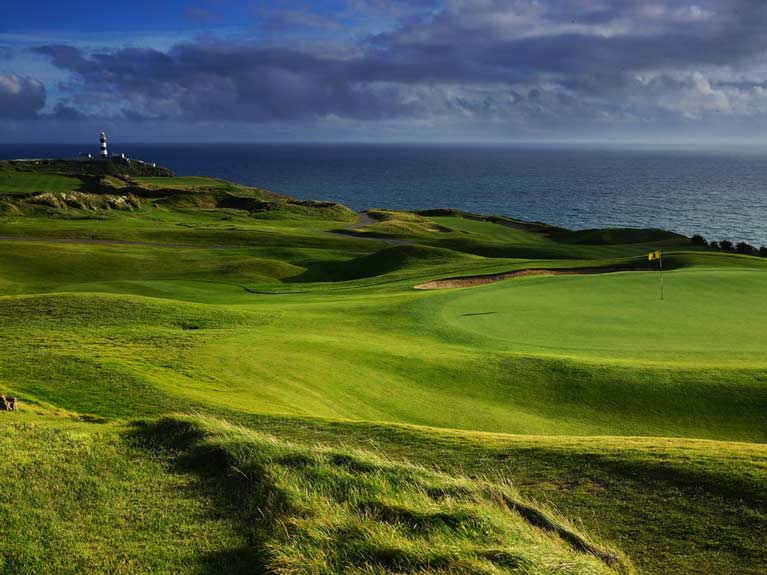 The Old Head Golf Course near Kinsale – it may be very artificially green, but it is preferable to industrial or urban sprawl
The Old Head Golf Course near Kinsale – it may be very artificially green, but it is preferable to industrial or urban sprawl
As for the people for whom golf is pleasantly sedating, they cause trouble to no-one. An experienced hotelier in the west of Ireland once told me that the golfer is the perfect guest, easily pleased if you’ve the proper hospitality skills, and no trouble to anyone. He or she will return to the inn in a relaxed frame of mind after one or two rounds of their beloved game, and for dinner they’ll invariably have a steak with a bottle of red wine. Then they’ll retire peacefully to their rooms maybe with another bottle or a pint of Guinness, and there they’ll settle down in bed and watch a golf video before sleeping serenely.
It’s an entire segment of society kept content with a sense of purpose. So when the disruptors talk of doing away with distantly-located “perfect” start lines and Race Officers who will not let the fleets away until a dozen wind requirements are fully met, do they (the disruptors) not have enough humanity in them to think about what might become of the not-inconsiderable corps of volunteers who currently man committee boats and back-up RIBs and mark boats and heaven only knows what else that floats and can usefully be deployed to ensure that a smaller number of people actually get in some sort of race?
For the fact of the matter is, a fully-crewed and effectively-equipped and properly-organised Committee Boat with its various support boats is arguably a floating Men’s Shed (and yes, I know there are many splendid women involved too, God bless them).
So if we go back to simple shore-based starts using transits as Nature intended rather than having fully-manned boats bobbing about at sea, what on earth is going to become of those who have been called to Committee Boat service? For it’s not for everyone – it’s a sort of secret society, and there’s an invisible vetting process.
Either way, if we just pack a race officer into a little pier-end hut with a time-keeper and a records secretary and set up the transits for a reasonable start and then let the sailors at it within a few yards of the harbour mouth, we’re inevitably going to cast all those Committee Boat folk, mark buoy boys, and umpires into a sort of purposeless outer darkness.
Perhaps they can take up golf…..Meanwhile, before this column is swamped into obliteration under an onslaught of Olympic Sailing Purity of Opinion, let it be pointed out that the Round Ireland Race starts from a shoreline, though admittedly with the race officer at the outer end in a Naval Service vessel if there’s one available. Elsewhere, much of Cowes Week and all of the Fastnet Race starts from a fixed shoreline. And as for the course, that’s then sailed, very little of it is round artificial marks other than established navigation buoys.
 Crazy but it works – the start of the Round Ireland Race 2014 as seen from the Wicklow pierhead
Crazy but it works – the start of the Round Ireland Race 2014 as seen from the Wicklow pierhead
And for those who object to racing where the effect of land regularly intrudes, just remember that the most popular participant sailing events in the world are the Round the Island Race around the Isle of Wight in the south of England, and the Round Gotland Race and other huge events involving close inshore stuff on islands in the Baltic.
Clearly, it’s what people want. And as for fancy Olympic courses in slightly remote area (ie more than two miles away from the harbour), they’re now soooo yesterday……Club sailors want convenience. If they want to go for a sail, they’ll simply go for a sail. But if they want a race, they don’t want to have to go for a sail before it. They want racing, and they want it now.
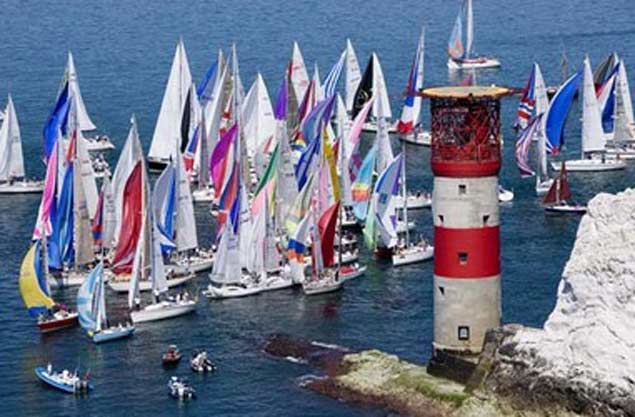 It’s sailing sport of a kind, but definitely not Olympic – the fleet in the Round the Island Race at the Needles, were those really cutting the corner have to be sure they pass safely inside the remains of a hidden shipwreck……
It’s sailing sport of a kind, but definitely not Olympic – the fleet in the Round the Island Race at the Needles, were those really cutting the corner have to be sure they pass safely inside the remains of a hidden shipwreck……
For a while, the ancient Howth 17s were told that the only racing that could be provided for them on a Saturday afternoon would be with the Puppeteer 22s (which carry an outboard auxiliary engine) at a Committee Boat start north of Ireland’s Eye in a supposedly clear area.
Yet if a calm fell, the Seventeens had to resort to a long oar, which was and is brutal to row with, and that’s it. So they rebelled, organized their own Race Officer rota for starts at the old pierhead line which they could reach within minutes from their moorings, and they’ve never looked back since. Saturday afternoon racing is the highlight of the week. So maybe if sailing organisers went by the old dictum of the customer being king, we might see club sailing becoming more healthy.
Here’s a vid of the Round the Island Race which usually starts at an ungodly hour of the morning, yet if you have a handy berth in the outer reaches of Cowes Harbour, you can leave it with just a quarter of an hour to go to your start. We’re not recommending that, but it can be done……
And as for those who like to claim that their nearest “clear area” really does minimize the need for local knowledge almost completely, let us remember the time when John Bertrand, America’s Cup-winning helm for Australia in 1983, finally achieved his true goal in life – becoming Etchells 22 World Champion in 2010, when it was staged in Howth.
For sure, the race area was set in the “clean zone” well clear of Howth, northwards between Ireland’s Eye and Lambay. But despite that, John Bertrand – whose crew for the big event was to include Tom Slingsby – spent six weeks (repeat: 6 weeks) in Howth beforehand, sailing his Etchells 22 morning, noon and night in the race area in order to get a complete feel for it and its many moods. He certainly deserved to win. But a bit of old-fashioned racing using a clear transit-marked shore-based starting line might have been more fun.
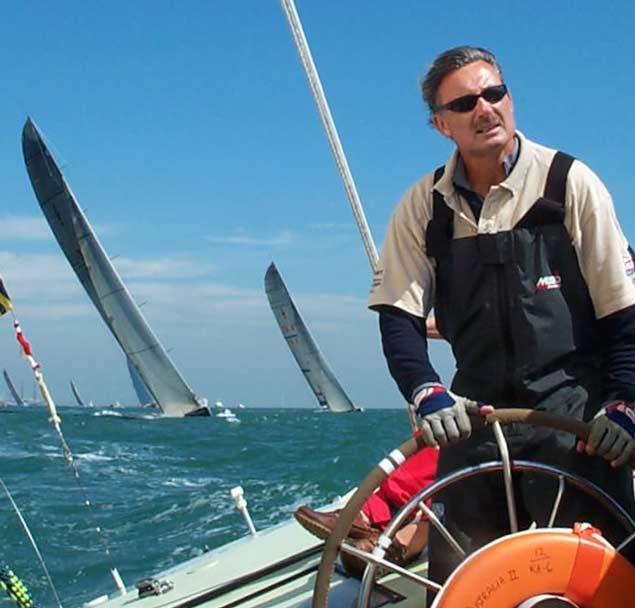 John Bertrand of Australia, who wrested the America’s Cup from the USA in 1983 for the first time since they originally won it in 1851. In 2010, he spent several weeks familiarizing himself with the “clear zone” sailing area off Howth before he raced on it to win the Etchells 22 Worlds
John Bertrand of Australia, who wrested the America’s Cup from the USA in 1983 for the first time since they originally won it in 1851. In 2010, he spent several weeks familiarizing himself with the “clear zone” sailing area off Howth before he raced on it to win the Etchells 22 Worlds



























